#1960 María M
Text
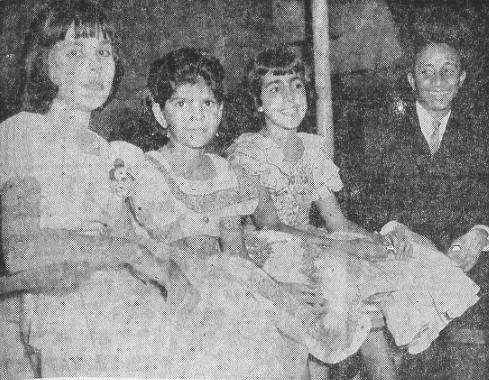

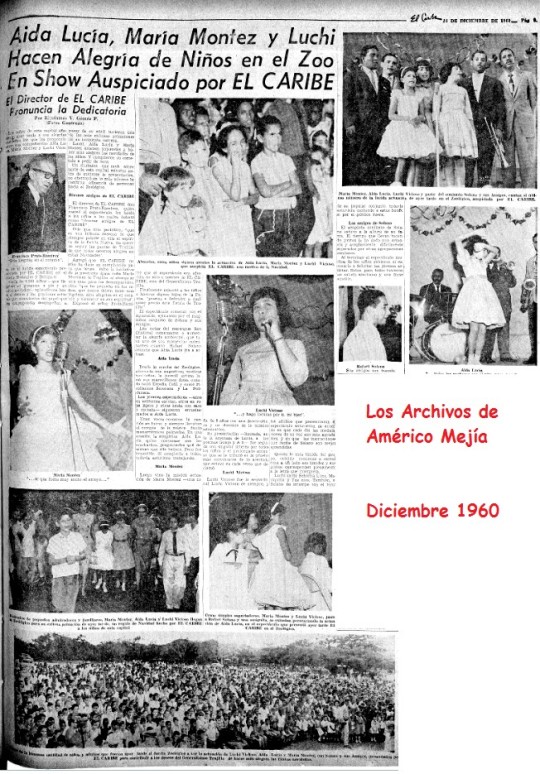
December 1960 - Press clippings/photos reporting the show Luchy Vicioso, María Montez II and Aida Lucia did a show in front of thousand kids in Zoological and Botanical Gardens of Dominican Republic. In the first photo they are seen with artist Rafael Solano.
First and third photos come from Los Archivos de Américo Mejía on Facebook. Used with kind permision from the owner. Thank you very much!!
Second photo comes from: El Caribe newspaper.
#María Montez II#Maria Montez II#María Montez Gracia Fiallo#MAria Montez Gracia Fiallo#1960 María M#Luchy Vicioso#Aida Lucia#Rafael Solano#child artist#singer#dancer#actress#TV actress#stage actress#Dominican press#El Caribe#Montez Family#Gracia Family
9 notes
·
View notes
Text
Cristobal Balenciaga
Cristobal Balenciaga was born in 1885 in Getaria which was a small fishing village in northern Spain. His mother was a stream stress which is how he ended up getting into fashion. He watched her and her clients which where the most fashionable and glamourous women in the village. At the age of only 12 he begin an tailoring apprenticeship in the neighbouring fashionable resort of stan Sebastian. This is where it all started for him as his first fashion house in 1917 named after a shortening of his mothers maiden name- Eisa. Balenciaga opened fashion houses in Barcelona and Madrid before moving to Paris in 1937 the fashion houses (Avenue Georges V) quickly became the cities most popular, most expensive and exclusive couturier. With the apprenticeships and his mother being a seamstress this training help set him apart from the other big designers of his time. With Cristóbal Balenciaga the design process for him started with the fabric not the sketch “it’s the fabric that decides” he stated, showing he could manipulate the materials to show there very best effect. Balenciaga knew the craft inside out and was adept at every stage of the making process. Balenciaga's Spanish heritage influenced a lot of the iconic designs. The wide hipped ‘infanta’ dress from his 1930s collection drew inspiration from the 17th century Spanish artist Diego Velázquez. In the later phase of his career, in the 1950s Balenciaga was pioneering with new shapes never seen before in the women's fashion industry. The radical designs developed season by season as he redefined and reworked at the looks created his style and a name for himself and his fashion house. In 1957 he shocked the fashion world with the introduction of the 'sack dress', a straight up and down shift dress which completely eliminated the waist. At a time when Christian Dior's hour-glass shaped New Look was still dominant, the 'sack' was initially met with hostility from both clients and press. "It's hard to be sexy in a sack!" cried the Daily Mirror. Like many of Balenciaga's most radical designs, this look eventually filtered into the mainstream. The sack dress was the forerunner of the ubiquitous mini-dress of the 1960s and remains a fashion staple today. He then retired and past on the fashion house, however Balenciaga came out of retirement in 1972 to create the wedding dress of Spanish aristocrat and socialite María del Carmen Martínez-Bordiú , he sadly passed two weeks after this.
youtube
youtube
Product- Balenciaga has had many collection over the year all by different designers but all the product and innovative designs and one on there own, they have women and menswear, something for everyone with each collection they bring out. The brand has ready to wear items, leather goods, shoes, bags and apparel for men and women
Price- Balenciaga's is a brand based on luxury items meaning their prices are very expensive so there have a small group in their target market and very few people can afford to pay the extreme amount of money for just one items.
Place- Balenciaga sell they product online and in store however their main source for purchasing their items is probably online as everyone can access this and is the most relevant way to buy anything now and will be for a long period of time. The items in store are very limited as not a lot of store carry items like these as such as luxurious at Balenciaga's products.
Promotion- Balenciaga advertise in big cities such as Mumbai, New Delhi and Chandigarh just a few examples, they do a lot of celebrity marketing this is such a clever idea to promote a brand as when people see big celebrities wearing the brand, they immediately want to own that, Balenciaga did this with Kim Kardashian she wore a lot of Balenciaga recently which was such a smart idea as Kim is so relevant and on trend now. They also use a lot of social media which is probably the most relevant way of promoting these day as everyoneis using social media and doing campaigns on social media you know everyone will be seeing this and if people are liking and sharing this they can use this of a way of feedback for the company.
youtube
Nicolas Ghesquiere took a freelance job that took him to Balenciaga in 1995, when the Balenciaga creative director Josephus Thimister however he was fired two year later, and Nicolas tapped in and it was the start of his 15-year run at Balenciaga. Nicolas reportedly doubled the income of Balenciaga's sale when arriving. Whilst at Balenciaga he delivered us the 1980s inspired fashion and the iconic lariat handbag, he went on to expand the number of collection for Balenciaga and continued to produce innovative design such as the short gladiator style skirt and the toga dresses, knee high gladiator sandals and so much more like collections inspired by some of Balenciaga's original designs.
youtube
Balenciaga’s target audience is men and women who live a luxury lifestyle and prefer a different side of sophisticated, however now the time and generation has changed the new target audience is the new generation of fashion enthusiasts. All the customers that buy Balenciaga's products are aware of the trends in fashion and the fashion world of this generation. The target market for Balenciaga is a very wealthy group of people due to the high prices of all the products and especially if they are buying straight of the runway and the ready to wear collection.
Spring 2016 ready to wear runway is my favorite collection. The collection was designed by Alexander Wang just before he left. His final runway called swan song was said to be the freest collection he did for the house. All this collections was made entirely from shade of ivory, all in soft natural fabrics like linen cotton. All the designs looked effortless . The work for this collection started after the announcement that Wang would not be renewing his contract to the Balenciaga fashion house. His las collection was his best collection, some people believe this was because he let his guard down due to it being his last and wanting to focus on creating a signature label of his own. Although the vibes around this collection is very relaxed a lot of smocking, ruching and ladder stitching went into creating this collection while remaining light. I think the entire collection is so beautiful and elegant with also a bit of edge thrown into the mix which make it so interesting and caught my attention when looking through all the collection of Balenciaga throughout the year, this is with out a doubt my favorite, due to the effortlessly pretty vibes it has and all the shapes within the collection.
youtube
youtube
Harvard referencing
V&A () introducing Cristóbal Balenciaga[online] available from https://www.vam.ac.uk/articles/introducing-cristobal-balenciaga [accessed 7th November 2022
Britania(16th April 2016) Nicolas Ghesquière[online] available from https://www.britannica.com/biography/Nicolas-Ghesquiere [accessed 14th November 2022]
Elle (25th May 2017) A Look Back At Balenciaga's Most Iconic Moments Through History[online] available from https://www.elle.com/uk/fashion/trends/articles/g31790/balenciagas-most-iconic-moments/ [accessed 14th November 2022]
Vogue(2nd October 2015) Balenciaga Spring 2016 ready-to-wear [online] available from https://www.vogue.com/fashion-shows/spring-2016-ready-to-wear/balenciaga [accessed 14th November 2022]

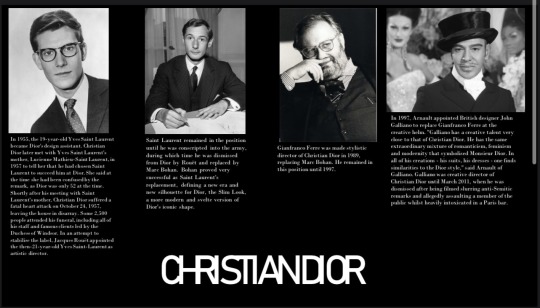
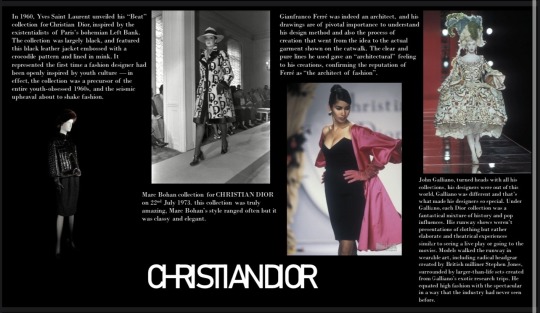
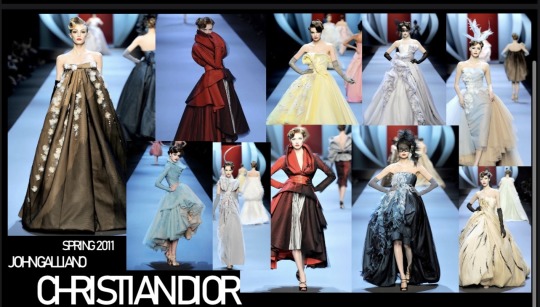
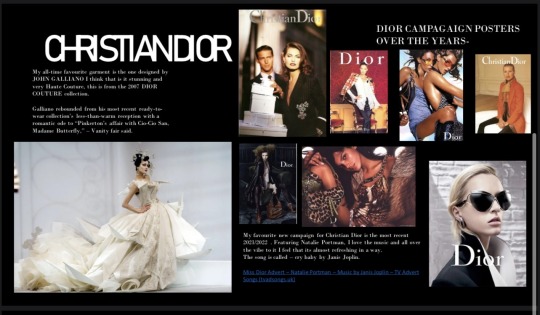
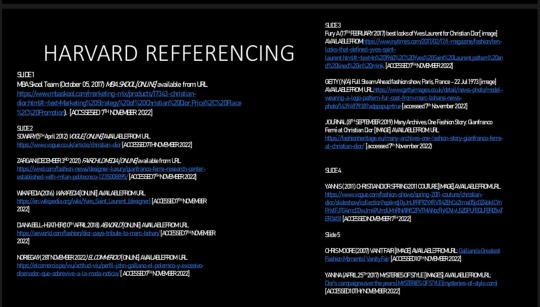
3 notes
·
View notes
Text

1974.
1971
.
María Isabel Llaudes Santiago, (Dec 4- 1945, Jaén, Spain ) better known by her stage name Karina, is a Spanish singer and actress who had her biggest success from the late 1960s until the mid-1970s in Spain and Latin America.

Karina, 1971 Eurovision song contest.






Karina was born in Jaén, Andalusia, to Trinidad Santiago and Salvador Llaudes. She has been married four times and has two daughters. In recent years, she has been diagnosed with thyroid cancer but has since made a full recovery. Spouses :
Tony Luz (m. 1973; div. 1975)
Carlos Manuel Díaz (m. 1981; div. 1987)
Juan Miguel (m. 1988; div. 1990),
Domingo Torroba (m. 2000; div. 2002)
https://www.instagram.com/karina_artista_oficial?igsh=Ym53eTE4cDIwdGFy
0 notes
Text
2021 Reading and Watching Resolutions
2020 is dead! It’s a new year, and with it come a new set of reading and watching resolutions. A few small tweaks, but these are mostly the same lists as last time. If you see any categories that you have recommendations for, feel free to drop me a line.
2021 Reading Resolution
A book written in North America: Son of a Trickster by Eden Robinson
A book written in Central America/Caribbean: Annie John by Jamaica Kincaid
A book written in South America: Full Woman, Fleshly Apple, Hot Moon: Selected Poems of Pablo Neruda by Pablo Neruda, translated by Stephen Mitchell
A book written in East Asia: I Am a Hero: Omnibus Volume 1 by Kengo Hanazawa
A book written in South Asia: A Burning by Megha Majumdar
A book written in Africa: Freshwater by Akwaeke Emezi
A book written in the Middle East: Death is Hard Work by Khaled Khalifa
A book written in Australia/Pacific Islands: Gideon the Ninth by Tamsyn Muir
A book written in Russia: The Blizzard by Vladimir Sorokin
A book written in Europe: White Is for Witching by Helen Oyeyemi
A biography: Shirley Jackson: A Rather Haunted Life by Ruth Franklin
A non-fiction book: Forgiveness: A Gift from My Grandparents by Mark Sakamoto
A collection of short stories: A Short History of Indians in Canada by Thomas King
A collection of poetry: Night Sky with Exit Wounds by Ocean Vuong
A play: The Importance of Being Earnest by Oscar Wilde
A book you’ve seen adapted: Tipping the Velvet by Sarah Waters
A graphic novel: Die Vol 2: Split the Party by Kieron Gillen, illustrated by Stephanie Hans
A children’s book: Valley of the Moon: The Diary of María Rosalía de Milagros by Sherry Garland
A book older than 100 years: The King in Yellow by Robert W. Chambers
A debut novel: I Am Not a Serial Killer by Dan Wells
A novel by a famous author, other than the one(s) they are best known for: Pericles by William Shakespeare
A sequel: The Sugared Game (The Will Darling Adventures #2) by KJ Charles
A book by an author you’ve never given a fair shot: Along Came A Spider by James Patterson
A book you’ve heard bad things about: The Host by Stephenie Meyer
A book released in 2021: Subtle Blood (The Will Darling Adventures #3) by KJ Charles
Wild Card: Slippery Creatures (The Will Darling Adventures #1) by KJ Charles
Wild Card: Universal Harvester by John Darnielle
Wild Card: Dream Daddy: A Dad Dating Comic Book by Leighton Gray and Vernon Shaw
Wild Card: Ring by Koji Suzuki
Wild Card: The Degenerates by J. Albert Mann
Bonus Reading:
A Disability History of the United States by Kim E. Nielsen
The Subsidiary by Matías Celedón
I’ll Never Get Out of This World Alive by Steve Earle
Venomous: How Earth's Deadliest Creatures Mastered Biochemistry by Christie Wilcox
Binti by Nnedi Okorafor
The Burning Girls by C.J. Tudor
List Progress: 36/30
2021 Film Watching Resolution
A foreign film: Beware of Children (Barn) (2019)
A black and white film: M (1931)
A silent or dialogue-free film: Modern Times (1936)
An animated film: Fantastic Planet (1973)
A film based on a true story: Radium Girls (2018)
A documentary: Heroin(e) (2017)
A film based on a book: In the Tall Grass (2019)
An Oscar-winning movie: Rebecca (1940)
A trashy movie: Equilibrium (2002)
Your best friend’s recommendation: Arsenic and Old Lace (1944)
A children’s film: The Secret World of Arrietty (2010)
A film released in 2021: The Woman in the Window (2021)
List Progress: 12/12
Movies Outside the List:
Booksmart (2019)
All-In Madonna (2020)
Shiva Baby (2020)
Vera Drake (2004)
Ma (2019)
The Exorcist (1973)
The Omen (1976)
The Ring (2002)
Downton Abbey (2019)
The Clovehitch Killer (2018)
The Dance of the 41 (El baile de los 41) (2020)
Saint Maud (2019)
Unfriended (2014)
Psycho (1960)
Tampopo (1985)
Dear Evan Hansen (2021)
tick, tick...BOOM! (2021)
The Greatest Showman (2017)
The Night of the Hunter (1955)
I Think We’re Alone Now (2018)
Pride (2014)
10 Cloverfield Lane (2016)
6 notes
·
View notes
Text
End of the Comfort Zone Bingo, thoughts, and conclusions
I just finished the Comfort Zone Bingo!! I'm super happy because I managed to finish it before the end of the month, so here is the I-finished-yay-post :)
What is the Comfort Zone Bingo?
It's a creation by @anassarhenisch. You just ask for a bingo card and she gives you one to tackle. The prompts are super random, and the idea is, well, to read outside your comfort zone. I started my card in April, so I needed a little under three months to finish!
How did it go?
Fantastically! I had to do a mad scramble in some prompts, but I guess that was the goal, right? I liked most of what I read, I tackled some forever-on-my-TBR books (LES MIS) and I discovered some new authors I loved. However, I have to admit that the prompts I got weren't too difficult, so while I appreciate that (I didn't go crazy looking up books to fit in), I feel like I didn't push myself out of my comfort zone too hard.
Overall, 10/10, I would do it again. I love bingos!
Here is my card, and below the cut a list of what I read, in chronological reading order and with reviews linked.

Historical fiction: The Diviners (The Diviners #1) - Libba Bray [Review]
Paranormal: Late Eclipses (October Daye #4) - Seanan McGuire
From another continent: One Sea Salt (October Daye #5) - Seanan McGuire
Picture book: The Sleeper and the Spindle - Neil Gaiman
Reread: A Study in Scarlet (Sherlock Holmes #1) - Arthur Conan Doyle
Translated from another language: The Sign of Four (Sherlock Holmes #2) - Arthur Conan Doyle [I read it in Spanish]
Romance: An Enchantment of Ravens - Margaret Rogerson [Review]
No romance: The Handmaid's Tale (#1) - Margaret Atwood [Review]
Written between 1960 and 1980: The Madwoman in the Attic: The Woman Writer and the 19th Century Literary Imagination - Sandra M. Gilbert & Susan Gubar
Contemporary: The Foxhole Court (All for the Game #1) - Nora Sakavic
Chosen One: Ashes of Honor (October Daye #6) - Seanan McGuire
Steampunk: The Friday Society - Adrienne Kress
Free: Insólitas - Anthology, various authors *
From your country: How They Rule the World - Pedro Baños
Creepy setting: A Winter's Promise (The Mirror-Visitor #1) - Christelle Dabos
Women's fiction: La vida más patética - Dryadeh Lair *
Literary fiction: The Mermaid and Mrs. Hancock - Imogen Hermes Gowar
Prophecies: Dido para Eneas - María García Esperón *
True crime: Death at the Priory: Love, Sex, and Murder in Victorian England - James Ruddick
Heist: The Heist (Fox and O'Hare #1) - Janet Evanovitch & Lee Goldberg [Review]
Written before 400 CE: Lysistrata - Aristophanes
Talking animals: Contes - Hans Christian Andersen
On TBR for 5 years: Les Miserables - Victor Hugo
Thriller: Twist of Faith (Ava Saunders #1) - Ellen J. Green
Series you never finished: Chimes at Midnight (October Daye #7) - Seanan McGuire
* Only available in Spanish
(It does look a bit like “How many October Daye books can I fit in one card?”)
12 notes
·
View notes
Text
Juan 12 Reina-Valera 1960 Jesús es ungido en Betania (Mt. 26.6-13; Mr. 14.3-9) 12 Seis días antes de la pascua, vino Jesús a Betania, donde estaba Lázaro, el que había estado muerto, y a quien había resucitado de los muertos. 2 Y le hicieron allí una cena; Marta servía, y Lázaro era uno de los que estaban sentados a la mesa con él. 3 Entonces María tomó una libra de perfume de nardo puro, de mucho precio, y ungió los pies de Jesús, y los enjugó con sus cabellos; y la casa se llenó del olor del perfume. 4 Y dijo uno de sus discípulos, Judas Iscariote hijo de Simón, el que le había de entregar: 5 ¿Por qué no fue este perfume vendido por trescientos denarios, y dado a los pobres? 6 Pero dijo esto, no porque se cuidara de los pobres, sino porque era ladrón, y teniendo la bolsa, sustraía de lo que se echaba en ella. 7 Entonces Jesús dijo: Déjala; para el día de mi sepultura ha guardado esto. 8 Porque a los pobres siempre los tendréis con vosotros, mas a mí no siempre me tendréis. El complot contra Lázaro 9 Gran multitud de los judíos supieron entonces que él estaba allí, y vinieron, no solamente por causa de Jesús, sino también para ver a Lázaro, a quien había resucitado de los muertos. 10 Pero los principales sacerdotes acordaron dar muerte también a Lázaro, 11 porque a causa de él muchos de los judíos se apartaban y creían en Jesús. La entrada triunfal en Jerusalén (Mt. 21.1-11; Mr. 11.1-11; Lc. 19.28-40) 12 El siguiente día, grandes multitudes que habían venido a la fiesta, al oír que Jesús venía a Jerusalén, 13 tomaron ramas de palmera y salieron a recibirle, y clamaban: !!Hosanna! !!Bendito el que viene en el nombre del Señor, el Rey de Israel! 14 Y halló Jesús un asnillo, y montó sobre él, como está escrito: 15 No temas, hija de Sion; He aquí tu Rey viene, Montado sobre un pollino de asna. m 16 Estas cosas no las entendieron sus discípulos al principio; pero cuando Jesús fue glorificado, entonces se acordaron de que estas cosas estaban escritas acerca de él, y de que se las habían hecho. 17 Y daba testimonio la gente que estaba con él cuando llamó a Lázaro del sepulcro, y le resucitó de los muertos. 18 Por lo cual también había venido la gente a recibirle, porque había oído que él había hecho esta señal. 19 Pero los fariseos dijeron entre sí: Ya veis que no conseguís nada. Mirad, el mundo se va tras él. Unos griegos buscan a Jesús 20 Había ciertos griegos entre los que habían subido a adorar en la fiesta. 21 Estos, pues, se acercaron a Felipe, que era de Betsaida de Galilea, y le rogaron, diciendo: Señor, quisiéramos ver a Jesús. 22 Felipe fue y se lo dijo a Andrés; entonces Andrés y Felipe se lo dijeron a Jesús. 23 Jesús les respondió diciendo: Ha llegado la hora para que el Hijo del Hombre sea glorificado. 24 De cierto, de cierto os digo, que si el grano de trigo no cae en la tierra y muere, queda solo; pero si muere, lleva mucho fruto. 25 El que ama su vida, la perderá; y el que aborrece su vida en este mundo, para vida eterna la guardará. 26 Si alguno me sirve, sígame; y donde yo estuviere, allí también estará mi servidor. Si alguno me sirviere, mi Padre le honrará. Jesús anuncia su muerte 27 Ahora está turbada mi alma; ¿y qué diré? ¿Padre, sálvame de esta hora? Mas para esto he llegado a esta hora. 28 Padre, glorifica tu nombre. Entonces vino una voz del cielo: Lo he glorificado, y lo glorificaré otra vez. 29 Y la multitud que estaba allí, y había oído la voz, decía que había sido un trueno. Otros decían: Un ángel le ha hablado. 30 Respondió Jesús y dijo: No ha venido esta voz por causa mía, sino por causa de vosotros. 31 Ahora es el juicio de este mundo; ahora el príncipe de este mundo será echado fuera. 32 Y yo, si fuere levantado de la tierra, a todos atraeré a mí mismo. 33 Y decía esto dando a entender de qué muerte iba a morir. 34 Le respondió la gente: Nosotros hemos oído de la ley, que el Cristo permanece para siempre. ¿Cómo, pues, dices tú que es necesario que el Hijo del Hombre sea levantado? ¿Quién es este Hijo del Hombre? 35 Entonces Jesús les dijo: Aún por un poco está la luz entre vosotros; andad entre tanto que tenéis luz, para que no os sorprendan las tinieblas; porque el que anda en tinieblas, no sabe a dónde va. 36 Entre tanto que tenéis la luz, creed en la luz, para que seáis hijos de luz. Incredulidad de los judíos Estas cosas habló Jesús, y se fue y se ocultó de ellos. 37 Pero a pesar de que había hecho tantas señales delante de ellos, no creían en él; 38 para que se cumpliese la palabra del profeta Isaías, que dijo: Señor, ¿quién ha creído a nuestro anuncio? ¿Y a quién se ha revelado el brazo del Señor? m 39 Por esto no podían creer, porque también dijo Isaías: 40 Cegó los ojos de ellos, y endureció su corazón; Para que no vean con los ojos, y entiendan con el corazón, Y se conviertan, y yo los sane. m 41 Isaías dijo esto cuando vio su gloria, y habló acerca de él. 42 Con todo eso, aun de los gobernantes, muchos creyeron en él; pero a causa de los fariseos no lo confesaban, para no ser expulsados de la sinagoga. 43 Porque amaban más la gloria de los hombres que la gloria de Dios. Las palabras de Jesús juzgarán a los hombres 44 Jesús clamó y dijo: El que cree en mí, no cree en mí, sino en el que me envió; 45 y el que me ve, ve al que me envió. 46 Yo, la luz, he venido al mundo, para que todo aquel que cree en mí no permanezca en tinieblas. 47 Al que oye mis palabras, y no las guarda, yo no le juzgo; porque no he venido a juzgar al mundo, sino a salvar al mundo. 48 El que me rechaza, y no recibe mis palabras, tiene quien le juzgue; la palabra que he hablado, ella le juzgará en el día postrero. 49 Porque yo no he hablado por mi propia cuenta; el Padre que me envió, él me dio mandamiento de lo que he de decir, y de lo que he de hablar. 50 Y sé que su mandamiento es vida eterna. Así pues, lo que yo hablo, lo hablo como el Padre me lo ha dicho.
1 note
·
View note
Text
Here's my list of movies i think criterion should add:
Homecoming 2019, high life 2018, spiderman: into the spiderverse 2018, if beale street could talk 2018, the favourite 2018, Madeline's madeline 2018, hereditary 2018, sorry to bother you 2018, mandy 2018, won't you be my neighbor? 2018, blindspotting 2018, phantom thread 2017, coco 2017, thor: ragnarok 2017, roman israel eq. 2017, i tonya 2017, sweet country 2017, the shape of water 2017, loving vincent 2017, you were never really here 2017, i am not a witch 2017, the killing of a sacred deer 2017, the Florida project 2017, the rider 2017, okja 2017, marlina the murderer in four acts 2017, it comes at night 2017, bombshell 2017, the life and death of marsha p johnson, gods own country 2017, get out 2017, beach rats 2017, columbus 2017, thoroughbreds 2017, novitiate 2017, i am not your negro 2016, lion 2016, voyage of time 2016, moonlight 2016, the handmaiden 2016, american honey 2016, kedi 2016, the love witch 2016, Christine 2016, hunt for the wilderpeople 2016, swiss army man 2016, room 2015, the fits 2015, kaili blues 2015, sicario 2015, the lobster 2015, the witch 2015, paddington 2014, selma 2014, gone girl 2014, nightcrawler 2014, birdman 2014, it follows 2014, a girl walks alone at night 2014, what we do in the shadows 2014, obvious child 2014, the babadook 2014, 12 years a slave 2013, under the skin 2013, enemy 2013, stoker 2013, the master 2012, beasts of a southern wild 2012, the skin i live in 2011, we need to talk about Kevin 2011, boy 2010, a single man 2009, Jennifer's body 2009, there will be blood 2007, things we lost in the fire 2007, superbad 2007, eagle vs shark 2007, ratatouille 2007, children of men 2006, the fall 2006, talladega nights 2006, little miss sunshine 2006, pride and prejudice 2005, brokeback mountain 2005, sympathy for lady vengeance 2005, hard candy 2005, million dollar baby 2005, spiderman 2 2005, mysterious skin 2004/05, shrek 2 2004, big fish 2003, elephant 2003, blue 2002, lilya 4-ever 2002, real women have curves 2002, shrek 2001, george Washington 2000, amores perros 2000, in the mood for love 2000, yi yi 2000, the matrix 1999, the big lebowski 1998, life is beautiful 1997, boogie nights 1997, eve's bayou 1997, princess mononoke 1997, bound 1996, heavenly creatures 1994, vive l'amour 1994, muriels wedding 1994, forrest gump 1994, jurassic park 1993, the scent of green papaya 1993, the piano 1993, raise the red lantern 1991, boyz n the hood 1990, point break 1990, silence of the lambs 1990, twin peaks 1989, drugstore cowboy 1989, bashu the stranger 1988, grave of the fireflies 1988, my neighbor totoro 1988/87, maurice 1987, predator 1987, raising arizona 1987, come and see 1985, blood simple 1984, that day on the beach 1983, the thing 1981, possession 1981, the elephant man 1980, alien 1979, halloween 1978, place without limits 1978/77, young Frankenstein 1974, alice doesnt live here anymore 1973, the exorcist 1973, paper moon 1972, ganja & hess 1972, let's scare jessica to death 1970, count dracula 1970, eros+massacre 1969, once upon a time in the west 1968, planet of the apes 1968, barefoot in the park 1967, the affair 1967, grand prix 1966, woman of the lake 1966, this property is condemned 1966, seconds 1966, faster, pussycat! Kill, kill! 1965, hush... Hush, sweet charlotte 1964, zorba the greek 1964, the visit 1964, the young one 1960, good-for-nothing 1960, macario 1960, the burglar 1957, the fastest gun alive 1955, picnic 1955, rebel without a cause 1955, kiss me deadly 1955, ensayo de un crimen 1954, carmen jones 1954, johnny guitar 1954, from here to eternity 1953, pickup on south street 1953, el bruto 1952, lightning 1952, a streetcar named desire 1951, a place in the sun 1951, los olvidados 1950, no way out 1950, sunset boulevard 1950, night and the city 1950, the quiet duel 1949, unfaithfully yours 1948, la perla 1947, enamorada 1946, scarlet street 1945, leave her to heaven 1945, mildred pierce 1945, laura 1944, María Candelaria 1943, cat people 1942, moon over miami 1941, strawberry blonde 1940, the thin man 1934, vampyr 1932 and m 1931
**BOLD IS FOR MOVIES I THINK ARE THE HIGHEST BIDDERS TO GET ON CRITERION SOON, PLEASE NOTIFY ME IF SOME OF THESE ARE ON CRITERION ALREADY**
#Cherry says#OKAY IM DONE!!!#TOOK ME ALL WEEK TO DO IT#ESPECIALLY WITH MOBILE GLITCHING#AND HAVING TO REDO IT#if u wanna know why i picked it please send me an ask#i would be honored to explain
26 notes
·
View notes
Text
World Poll 2019
Great recent movies (made since 2014) seen for the first time in 2019
Mademoiselle de Joncquières (Emmanuel Mouret, 2018)
Dau Huduni Methai (Song of the Horned Owl, Manju Borah, 2015)
El Crack cero (José Luis Garci, 2019)
Jiang hu er nv (Ash is Purest White, Jia Zhang-ke, 2018)
Carré 35 (Plot 35, Éric Caravaca, 2017)
Sic transit Gloria Mundi (Gloria Mundi, Robert Guédiguian, 2019)
If Beale Street Could Talk (Barry Jenkins, 2018)
Ad Astra (James Gray, 2019)
Le Chant du loup (The Wolf’s Call, Antonin Braudy, 2019)
Shooting the Mafia (Kim Longinotto, 2019)
Village Rockstars (Rima Das, 2017)
Tantas Almas (Valley of Souls, Nicolás Rincón Gille, 2019)
Un peuple et son roi (Pierre Schoeller, 2018)
Aamis (Ravening, Bhaskar Hazarika, 2018/9)
Fishbone (Adán Aliaga, 2018)
O que arde (Fire Will Come, Oliver Laxe, 2019)
La Fin de la nuit (Lucas Belvaux, 2015)
Ramen Teh (Ramen Shop, Eric Khoo, 2018)
Light of My Life (Casey Affleck, 2019)
Great movies (made before 2014) seen for the first time in 2019
’49-’17 (Ruth Ann Baldwin, 1917)
Ba shan ye yu (Evening Rain / Night Rain of Mount Ba, Wu Yigong and Wu Yonggang, 1980)
The Spirit of the Flag (Allan Dwan, 1913)
Versailles (Pierre Schoeller, 2008)
Ùn pienghjite mica (Les Anonymes, Pierre Schoeller, 2012/3)
Foxfire (Joseph Pevney, 1954/5)
Johnny Come Lately (William K. Howard, 1943)
I girovaghi (Hugo Fregonese, 1956)
Nunal sa Tubig (Speck in the Water, Ishmael Bernal, 1976)
Ikaw ay Kin (You Are Mine, Ishmael Bernal, 1978)
Pervyí eshielon (The First Convoy, Mikhail Kalatozov, 1955/6)
The Sea Wolf (Alfred Santell, 1930)
Surrender (William K. Howard, 1931)
The Restless Years (Helmut Käutner, 1958)
Darling, How Could You! (Mitchell Leisen, 1951)
Ko:Yad (A Silent Way, Manju Borah, 2012)
The Flame (John H. Auer, 1947)
Ernst Thälmann-Sohn seiner Klasse (Kurt Maetzig, 1954)
Ernst Thälmann-Führer seiner Klasse (Kurt Maetzig, 1955)
Bólshaia Sémia (A Big Family, Iosif Kheífits, 1954)
Circuit Carole (Emmanuelle Cuau, 1995)
Harvey (Henry Koster, 1950)
As It Is in Life (D.W. Griffith, 1910)
Abroad with Two Yanks (Allan Dwan, 1944)
Behind Office Doors (Melville W. Brown, 1931)
Lovin’ The Ladies (Melville W. Brown, 1930)
La Tarea o cómo la pornografía salvó del tedio y mejoró la economía de la familia Partida (Homework, Jaime Humberto Hermosillo, 1990/1)
A Modern Hero (G.W. Pabst, 1934)
Surrender (William K. Howard, 1931)
Jubilee Trail (Joseph Inman Kane, 1954)
Matinée (Jaime Humberto Hermosillo, 1976/7)
Linda (Mrs. Wallace Reid = Dorothy Davenport, 1928/9)
Die missbrauchten Lebesbriefe (Leopold Lindtberg, 1940)
Very good movies (made since 2014) seen for the first time in 2019
Photograph (Ritesh Batra, 2019)
The Mule (Clint Eastwood, 2018)
The Man Who Killed Hitler and Then The Bigfoot (Robert D. Krzykowski, 2018)
Frères ennemis (Close Enemies, David Oelhoffen, 2018)
L’Homme fidèle (A Faithful Man, Louis Garrel, 2018)
Pris de court (Not on My Watch, Emmanuelle Cuau, 2016)
Dolor y Gloria (Pain and Glory, Pedro Almodóvar, 2019)
Frost (Šerkšnas, Sharunas Bartas, 2017)
Vitalina Varela (Pedro Costa, 2019)
Da xiang xi di er zuo (An Elephant Sitting Still, Hu Bo, 2018)
Di qiu zui hou de ye wan (Long Day’s Journey Into Night, Bi Gan, 2018)
La Tenerezza (Tenderness, Gianni Amelio, 2017)
Fourteen (Dan Sallitt, 2019)
Bulbul Can Sing (Rima Das, 2018)
A Rainy Day in New York (Woody Allen, 2019)
Legado en los huesos (Fernando González Molina, 2019)
Ma vie dans l’Allemagne d’Hitler (My Life in Hitler’s Germany, Jérôme Prieur, 2018)
La Vie balagan de Marceline Loridan-Ivens (Yves Jeuland, 2018)
Gangbyeon Hotel (Hotel by the River, Hong Sang-soo, 2018)
The Wind (Emma Tammi, 2018)
Kothanodi (The River of Fables, Bhaskar Hazarika, 2015)
Dar Jostojoy-e Farideh (Finding Farideh, Azadeh Moussavi & Kourosh Ataee, 2018)
Sir (Rohena Gera, 2018)
El Proyeccionista (The Projectionist, José María Cabral, 2019)
Intemperie (Benito Zambrano, 2019)
Madre (Mother, Rodrigo Sorogoyen, 2017, short)
Three Identical Strangers (Tim Wardle, 2018)
Madre (Rodrigo Sorogoyen, 2019)
Very good movies (made before 2014) seen for the first time in 2019
A Life for a Kiss (Allan Dwan, 1912)
Futari de aruita iku haru aki (The Days We Spent Together, Kinoshita Keisukē, 1962)
The Necklace (D.W. Griffith, 1909)
Das Schiff der verlorenen Menschen (Ship of Lost Men, Maurice Tourneur, 1929)
The Broken Locket (D.W. Griffith, 1909)
Primrose Hill (Mikhaël Hers, 2007)
The Rejected Woman (Albert Parker, 1924)
El último malón (Alcides Greca, 1917)
Bullets for O’Hara (William K. Howard, 1941)
Le Récit de Rebecca (Paul Vecchiali, 1964)
La noche avanza (Night Falls, Roberto Gavaldón, 1952)
Over-Exposed (Lewis B. Seiler, 1956)
I rollerna tre (Christina Olofson, 1996)
Il Viale della Speranza (Dino Risi, 1953)
Because of You (Joseph Pevney, 1952)
1870/…Correva l’anno di grazia 1870 (Alfredo Giannetti, 1972)
Demi-tarif (Isild Le Besco, 2003)
L’Exercice de l’État (The Minister, Pierre Schoeller, 2011)
Cheng nan jiu shi (My Memories of Old Beijing / Old Stories of the Southern Part of the City, Wu Yigong, 1983)
Strangler of the Swamp (Frank Wisbar, 1945/6)
Sword in the Desert (George Sherman, 1949)
There’s Always Tomorrow (Too Late For Love;Edward Sloman, 1934)
East Side, West Side (Allan Dwan, 1927)
Le Départ (Damien de Pierpont, 1998)
Face aux fantômes (Jean-Louis Comolli, 2009)
The Eagle and the Hawk (Mitchell Leisen, credited to Stuart Walker, 1933)
Whirlpool (Roy William Neill, 1934)
The Animal Kingdom (Edgard H. Griffith; uc. George Cukor, 1932)
Le Passager (The Passenger, Éric Caravaca, 2005)
Razumov (Sous les yeux d’Occident) (Marc Allégret, 1936)
Banjo On My Knee (John Cromwell, 1936)
One Night of Love (Victor Schertzinger, 1934)
Enchantment (Robert G. Vignola, 1921)
Charell (Mikhaël Hers, 2006)
Men With Wings (William A. Wellman, 1938)
Delitto per amore (L’edera) (Augusto Genina, 1950)
Les Amants de Minuit/Les Amours de Minuit (Augusto Genina, 1930/1)
Human Cargo (Allan Dwan, 1936)
Up the Ladder (Edward Sloman, 1925)
Luxury Liner (Richard B. Whorf, 1948)
Surrender! (Edward Sloman, 1927)
The Judge (Elmer Clifton, 1948/9)
Turbión (Antonio Momplet, 1938)
Der Ruf (Josef von Báky, 1949)
Faubourg Montmartre (Raymond Bernard, 1931)
Träumerei (Harald Braun, 1944)
The Red Lantern (Albert Capellani, 1919)
El Paseíllo (Ana Mariscal, 1968)
La quiniela (Ana Mariscal, 1960)
Great movies growing up or just rediscovered in 2019
Letter of Introduction (John M. Stahl, 1938)
Only Yesterday (John M. Stahl, 1933)
Our Wife (John M. Stahl, 1941)
Wohin und zurück (Axel Corti, 1982-6)
Giorno per giorno, disperatamente (Alfredo Gianetti, 1961)
Die wunderbare Lüge der Nina Petrowna (Hanns Schwarz, 1929)
Alyonka (Boris Barnet, 1961)
Craig’s Wife (Dorothy Arzner, 1936)
Imitation of Life/Fannie Hurst’s “Imitation of Life” (John M. Stahl, 1934)
Captains Courageous (Victor Fleming, 1937)
Test Pilot (Victor Fleming, 1938)
The Eternal Sea (John H. Auer, 1955)
Hello, Sister! (Anonymous: Erich von Stroheim, Alfred L. Werker, Raoul Walsh, Alan Crosland, 1933)
La noche de enfrente (Night Across the Street, Raúl Ruiz, 2012)
Journey into Light (Stuart R. Heisler, 1951)
Feel My Pulse (Gregory LaCava, 1928)
La signora senza camelie (The Lady Without Camelias, Michelangelo Antonioni, 1953)
Nosotros que fuimos tan felices (Antonio Drove, 1976)
Very good movies improved
Liana (Boris Barnet, 1955)
L’Avventura (Michelangelo Antonioni, 1960)
Du haut en bas (High and Low, G.W. Pabst, 1933)
Amok (Antonio Momplet, 1944)
The Man Who Never Was (Ronald Neame, 1956)
Open Range (Kevin Costner, 2003)
Con la vida hicieron fuego (Ana Mariscal, 1959)
Timberjack (Joe Kane, 1954/5)
En la Palma de tu Mano (Roberto Gavaldón, 1951)
Gravity (Alfonso Cuarón, 2013)
Expreso de Andalucía (Francisco Rovira-Beleta, 1956)
El Camino (Ana Mariscal, 1963)
La viuda del capitán Estrada (José Luis Cuerda, 1991)
Vestida de azul (Antonio Giménez-Rico, 1983)
Segundo López aventurero urbano (Ana Mariscal, 1953)
Hell’s Outpost (Joe Kane, 1954)
Fuente: http://sensesofcinema.com/2020/world-poll/world-poll-2019-part-5/#4
3 notes
·
View notes
Photo

[TASK 102: COSTA RICA]
There’s a masterlist below compiled of over 150+ Costa Rican faceclaims categorised by gender with their occupation and ethnicity denoted if there was a reliable source. If you want an extra challenge use random.org to pick a random number! Of course everything listed below are just suggestions and you can pick whichever character or whichever project you desire.
Any questions can be sent here and all tutorials have been linked below the cut for ease of access! REMEMBER to tag your resources with #TASKSWEEKLY and we will reblog them onto the main! This task can be tagged with whatever you want but if you want us to see it please be sure that our tag is the first five tags, @ mention us or send us a messaging linking us to your post!
THE TASK - scroll down for FC’s!
STEP 1: Decide on a FC you wish to create resources for! You can always do more than one but who are you starting with? There are links to masterlists you can use in order to find them and if you want help, just send us a message and we can pick one for you at random!
STEP 2: Pick what you want to create! You can obviously do more than one thing, but what do you want to start off with? Screencaps, RP icons, GIF packs, masterlists, PNG’s, fancasts, alternative FC’s - LITERALLY anything you desire!
STEP 3: Look back on tasks that we have created previously for tutorials on the thing you are creating unless you have whatever it is you are doing mastered - then of course feel free to just get on and do it. :)
STEP 4: Upload and tag with #TASKSWEEKLY! If you didn’t use your own screencaps/images make sure to credit where you got them from as we will not reblog packs which do not credit caps or original gifs from the original maker.
THINGS YOU CAN MAKE FOR THIS TASK - examples are linked!
Stumped for ideas? Maybe make a masterlist or graphic of your favourite faceclaims. A masterlist of names. Plot ideas or screencaps from a music video preformed by an artist. Masterlist of quotes and lyrics that can be used for starters, thread titles or tags. Guides on culture and customs.
Screencaps
RP icons [of all sizes]
Gif Pack [maybe gif icons if you wish]
PNG packs
Manips
Dash Icons
Character Aesthetics
PSD’s
XCF’s
Graphic Templates - can be chara header, promo, border or background PSD’s!
FC Masterlists - underused, with resources, without resources!
FC Help - could be related, family templates, alternatives.
Written Guides.
and whatever else you can think of / make!
MASTERLIST!
F:
Eugenia Fuscaldo (1953) Costa Rican - actress.
María Bonilla Picado (1954) Costa Rican - writer, actress, director, screenwriter and teacher.
Giannina Facio (1955) Costa Rican [Spanish, Catalan, possibly other] - actress and producer.
Madeleine Stowe (1958) Costa Rican [Spanish], German, Dutch, English - actress.
Maribel Guardia / Maribel Del Rocio Fernandez Garcia (1959) Costa Rican - actress, singer, model, and tv host.
Guadalupe Urbina (1959) Costa Rican - singer and artist.
Ana Istarú / Ana Soto Marín (1960) Costa Rican - actress and writer.
Marcia Saborío (1963) Costa Rican - actress, comedian, humorist and actress.
María Pretiz (1964) Costa Rican - singer-songwriter.
Tasia Valenza (1967) Costa Rican - actress.
Anastasia / Anastasia Acosta (1974) Costa Rican - actress and model.
Sasha Campbell (1977) Afro-Costa Rican - singer, journalist, broadcaster and television presenter.
Nancy Dobles Morales (1977) Costa Rican - presenter, model and actress.
Candice Michelle / Candice Michelle Beckman (1978) Costa Rican / German - actress, model, and retired professional wrestler.
Rosa Mendes / Milena Roucka (1979) Costa Rican / Czech - model and retired professional wrestler.
Shirley Álvarez (1980) Costa Rican - famous presenter and model.
Viviana Calderon (1980) Costa Rican - model and tv host.
Debi Nova / Deborah Nowalski Kader (1980) Costa Rican [Polish Jewish] - singer-songwriter, bassist, pianist, and dancer.
Veronica Bastos (1980) Costa Rican - tv host.
Francis Brunette / Francis Brunette Pastor Núñez (1982) Costa Rican / Mexican - actress, model, and singer.
Johanna Fernández (1982) Costa Rican - model and Miss Costa Rica Universe 2005.
Leonora Jiménez (1983) Costa Rican - model.
Marianela Quiros (1983) Costa Rican - model.
Veronica Gonzalez (1983) Costa Rican - model and Miss Costa Rica 2007.
Mia Rauz / Mia Araujo (1984) Costa Rican - singer.
Jessica Perez (1984) Costa Rican - actress and model.
Bali Rodriguez / Bárbara Laura Rodríguez Bonilla (1985) Costa Rican - actress and model.
Marva Wright (1985) Costa Rican - beauty queen.
Jale Berahimi (1985) Costa Rican - model and tv journalist.
Teresa Rodríguez (1986) Costa Rican - former beauty queen and television presenter.
Mariluz Bermudez (1986) Costa Rican - actress.
Heather Hemmens (1988) Afro Costa Rican / English - actress, producer, and director.
Wendy Cordero / Wendy del Carmen Cordero Sánchez (1988) Costa Rican - model and Miss Costa Rica World 2007.
Melissa Mora (1988) Costa Rican - singer, model, and tv personality.
Jessica Umaña (1988) Costa Rican - beauty queen.
Marcela Negrini / Marcela Negrina (1988) Costa Rican - model, tv presenter, and instagrammer (marcenegrini).
Brenda Kellerman (1988) Afro Costa Rican - actress, model, and tv host.
Maria Amalia Matamoros (1989) Costa Rican - model and beauty queen.
Tanner Mayes / Tanner Mayberry / Tanner Maze / Evangeline / Tanner Tanner Vivian Mayes (1989) Costa Rican - porn actress.
Amalia Matamoros (1989) Costa Rican - Miss Costa Rica World 2008.
Juliana Herz (1989) Costa Rican - model.
Carolina Rodríguez Durán (1989) Costa Rican - beauty queen, model, teacher and translator.
Fabiana Granados (1990) Costa Rican - model and Miss Costa Rica 2013.
Nazareth Cascante / Maria Nazareth Cascante Madrigal (1990) Costa Rican - model, Miss Costa Rica 2012, and Miss Teen International 2009.
Silvana Sánchez (1990) Costa Rican - Miss Costa Rica World 2012.
Elena Correa Usuga (1990) Costa Rican - is a beauty queen, model, and medical student.
Fabiana Granados Herrera (1990) Costa Rican - model and Miss Costa Rica 2013.
Johanna Solano (1990) Costa Rican - tv host, model, Miss Costa Rica 2011, and Miss Latin America 2009.
María José Castillo (1990) Costa Rican - singer.
Natalia Carvajal Sánchez (1990) Costa Rican - model, beauty queen, actress, presenter, publicist and student of literature.
Cata Freer (1991) Costa Rican - model.
Karina Campos (1991) Costa Rican - model and instagrammer (kariinacampos).
Nicole Carboni (1991) Costa Rican / French - model, athlete, presenter and beauty queen.
Joha Bermudez (1991) Costa Rican - model and instagrammer (johabc).
Brenda Castro (1992) Costa Rican - model and Miss Costa Rica 2015.
Gloriana Calderón (1992) Costa Rican - YouTuber.
Karina Ramos / Karina Ramos Leitón (1993) Costa Rican - model , queen of beauty, presenter, broadcaster and buisnesswoman.
Valerie Sibaja (1993) Costa Rican - singer.
Kimberly Noèl (1993) Afro Cuban, Costa Rican, Puerto Rican, Italian - model, youtuber, and tv personality. - Trans!
Pamela Alfaro (1994) Costa Rican - model and tv presenter.
Steph Gonzalez (1994) model, tv presenter, and instagrammer (stephgj94).
Ruby O. Fee (1996) Costa Rican [German / French] - actress.
Krizz Solano (1997) Costa Rican - singer and YouTuber.
Adriana Mora (1998) Costa Rican - model and Instagrammer (moracmora).
Darianka Sanchez (2002) Costa Rican - model, instagrammer, and VSCO personality.
Danioverhere / Daniela Lopez (2002) Costa Rican - musical.ly star.
Sarai Gonzalez (2005) Costa Rican - actress.
Beatriz Brenes (?) Costa Rican - actress.
Aisha Duran (?) Costa Rican / Dominican - actress.
Raquel Almazan (?) Costa Rican - actress.
Carolina Solano (?) Costa Rican - actress, voice over artist, and director.
Laura Avila Tacsan (?) Costa Rican - actress and producer.
Kimiko Yeni Rojas (?) Costa Rican / Okinawan - actress.
Nadja Holtz (?) Costa Rican / German - actress.
Marianella Jimenez (?) Costa Rican - actress.
Amalia Chaves (?) Costa Rican - model and Instagrammer (amaliachr).
Natasha Jiménez (?) Costa Rican - author. - Trans!
Camille Valverde (?) Costa Rican - model and Insagrammer (camillevalverde).
Natalia Carvajal (?) Costa Rican - model, Miss Costa Rica Universe 2018, Miss Eco International 2016, and Instagrammer (natalia.carvajal_).
Paola (?) Costa Rican - model and Instagrammer (paoqm99).
Krista Browne (?) Costa Rican - model and Instagrammer (krista_browne).
Ivonne Cerdas Cascante (?) Costa Rican - model and Instagrammer (ivonnecerdas).
Lucia Alvarenga (?) Costa Rican - model and Instagrammer (lualvarengac).
Amélie (?) Costa Rican - model and Instagrammer (ameperera).
Swami (?) Costa Rican - model and Instagrammer (swamiaudino).
Mariajose Bonilla (?) Costa Rican - model and Instagrammer (mariajose.bonilla).
María González Roesch (?) Costa Rican - model,TV Host, Journalist, and Instagrammer (ameperera)
Vale / dondeestavale (?) Costa Rican - model and Instagrammer (dondeestavale).
Stephanie Msoto (?) Costa Rican - model, Instagrammer (stephanie_msoto) and Miss Tropico Costa Rica 2018.
Stephanie Sánchez (?) Costa Rican - model and Instagrammer (realsteph_sanchez).
Maki / mariajose.bonilla (?) Costa Rican - model and Instagrammer (realsteph_sanchez).
Déborah Dixon (?) Costa Rican - singer.
MishCatt / Michelle Gonzalez (?) Costa Rican - singer.
Marian Li (?) Costa Rican [Chinese / Unknown] - actress.
M:
Walter Ferguson (1919) Afro-Costa Rican - calypsonian.
Lencho Salazar (1931) Costa Rican - musician and folklorist.
Benjamín Gutiérrez (1937) Costa Rican - composer of contemporary classical music.
Manuel Monestel (1950) Afro-Costa Rican - musician and researcher.
Carlos Guzmán Bermúdez (1957) Costa Rican - musician, composer, producer, arranger and musical director.
Manuel Obregón López (1961) Costa Rican - composer and producer.
Rafael Rojas (1961) Costa Rican - actor and model.
Mario Maisonnave (1962) Argentinian, Costa Rican - singer, songwriter and producer.
Danilo Montero (1962) Costa Rican - singer and composer.
Isaias Gamboa (1963) Afro-Costa Rican - music producer, songwriter, musician, arranger, author and filmmaker.
Danny Burstein (1964) Costa Rican [Spanish] / Jewish - actor.
Juan Carlos Soto Marín (1965) Costa Rican - musician, builder and restorer of stringed musical instruments.
Richard Raphael (1966) Costa Rican / Jewish - actor and stuntman.
Tito Oses / William Federico Villalobos Oses (1967) Costa Rican - singer-songwriter, composer, actor, painter and music producer.
Rafa Ugarte (1968) Costa Rican - musician and composer.
Akinyele / Akinyele Adams (1970) Costa Rican / Afro Panamanian - rapper.
Manuel Marín Oconitrillo (1971) Costa Rican - writer and singer.
Daniel Moreno (1974) Costa Rican - actor, writer, and director.
J.P. Calderon / John Paul Calderon (1975) Costa Rican - model, reality tv personality, and volleyball player.
Luis Montalbert-Smith (1975) Costa Rican - singer.
Mario Alberto Chacón Jiménez (1975) Costa Rican - comedian and actor.
Roberto Zeledón (1977) Costa Rican - actor and producer.
Ari Borovoy (1979) Costa Rican [Polish Jewish] / Mexican - singer-songwriter and actor.
Jose Pablo Cantillo (1979) Costa Rican - actor.
Pieter Schlosser (1980) Dutch / Costa Rican [German] - film and television composer.
Hernán Jiménez (1980) Costa Rican - actor, comedian, director, and screenwriter.
Augusto Mejia (1980) Costa Rican - singer.
Ricardo Sossa (1980) Costa Rican / Colombian - singer.
Julio Nájera (1981) Costa Rican - musician.
Mauricio Herrera (1981) Costa Rican - singer and showman.
Alonso Fernández Alvarez (1982) Costa Rican - model and Mister Costa Rica 2009.
Harry Shum Jr. (1982) Costa Rican [Chinese] - actor, singer, dancer, and choreographer.
Italo Marenco (1983) Costa Rican - former soccer player, television presenter, actor and model.
Mauricio Hoffmann (1983) Costa Rican - tv host and reality star.
Renier Murillo / Renier J. Murillo (1984) Costa Rican / Ecuadorian - actor, director, and writer.
Lonrot / Gabriel Meoño Barahona (1986) Costa Rican - YouTuber.
Esteban Calderón (1987) Costa Rican - singer.
LobosJR / Mike Villalobos (1987) Costa Rican - Twitch streamer.
Bartosz Brenes (1989) Costa Rican, Polish, Belgian - house DJ, producer, remixer and record label owner.
Daniel Zovatto (1991) Costa Rican - actor.
Jefferson Kellerman (1991) Costa Rican - model and reality tv personality.
JimmyTutoriales (1996) Costa Rican - YouTuber.
Daniel Rövira (1999) 1/8 Costa Rican, 7/8 mix of Italian, Catalan, French, German, Swedish - actor.
Chris Tavarez / Christopher Tavarez (1992) Costa Rican, Dominican, Panamanian - actor and model.
Alex Badilla (1992) Costa Rican - Beauty YouTuber.
Alex Sanchez (1995) Costa Rican - actor, recording artist, songwriter, viner, musical.ly star, and instagrammer.
Charlie Herrera (1999) Costa Rican - YouNow star.
Adam Gifford (?) Costa Rican, Jamaican, Cherokee, Italian - actor.
Steve Howard (?) Costa Rican / Unspecified White - actor.
Andrew Rush (?) Costa Rican / Unknown (Presumably White) - actor and stuntman.
Byron Quiros (?) Costa Rican - actor, director, and choreographer.
Jose Palma (?) Costa Rican - actor.
Gustavo Bricno (?) Costa Rican - model and Instagrammer (gustvobricno).
Luis Morera Claramunt (?) Costa Rican - model and Instagrammer (luismoreracla).
Alejandro Q (?) Costa Rican - model and Instagrammer (alejandro.quesada).
Ariel Arguedas Devoto (?) Costa Rican - model and Instagrammer (arielardev).
Walter Flores (?) Costa Rican - musician.
Arnoldo Castillo Villalobos (?) Costa Rican - musician.
Problematic:
Kaya Jones / Chrystal Neria (1984) Jamaican (Unconfirmed), Nicaraguan (Unconfirmed), Costa Rican (Unconfirmed), Panamanian (Unconfirmed), Chinese (Unconfirmed) / Apache (Unconfirmed), Unspecified White - singer, violinist, DJ, model, actress, and dancer - Trump supporter who even has said she would like to put down the first brick in the wall on the Mexican border, has used multiple racial slurs, has compared the residential school system of Native Americans to white people willingly sending their kids to boarding schools, and honestly so much more.
10 notes
·
View notes
Text

Photo of young artist María Montez II pictured in July 1960.
Posted at Los Archivos de Américo Mejía facebook: https://www.facebook.com/losarchivosdeamericomejia
Used with kind permision from the owner. Thank you very much!!
#María Montez II#Maria Montez II#1960 María M#María Montez Gracia Fiallo#Maria Montez Gracia Fiallo#child artist#actress#TV actress#stage actress#dancer#Montez Family#Gracia Family
7 notes
·
View notes
Text
Marshall Mcluhan y la complejidad digital
María José López Niño

En este trabajo se discuten repercusiones de la vida de Mcluhan cómo sus estudios, sus trabajos, sus logros, sus libros etcétera. Relacionan a Mcluhan y la academia de América Latina de comunicación se deja claro que Marshall continuamente ha sido un hombre de medios con dificultad en la zona digital, además se habla de los cuestionamientos que se presentaban en las obras de Mcluhan en la educación de las ciencias de la comunicación en América latina basándose en horizontes marxistas y la teoría de las mediaciones. El desprestigio en las tesis de Mcluhan fueron comunes. Sus libros básicos lo han ubicado de los mass media. Enormes estudiosos y periodistas se sumaron para dialogar de los cuestionamientos a Mcluhan.
Herbert Marshall McLuhan nació el 21 de julio de 1911 en Edmonton, Alberta, Canadá. Estudió la licenciatura en letras y la maestría en artes en la Universidad de Manitoba. Marshall McLuhan se doctoró a los 31 años en la Universidad de Cambridge, y en su tesis doctoral, The place of Thomas Nashe in the learning of his time. En 1936 McLuhan comenzó su carrera académica, desempeñándose como maestro de literatura inglesa en la Universidad de Wisconsin. Un año después, en 1937, ha sido contratado en la Universidad de Saint Louis, en Missouri, En 1951 McLuhan redactó su primer libro: The mechanical bride. Folklor of industrial men. En aquel libro planteó una interesante afinidad: comprender al coche como una especie de novia. El carro justamente representa “la novia mecánica”.
“El mediólogo de Canadá Marshall McLuhan (1951) ha debutado en el escenario intelectual norteamericano, al rededor del siglo XX, con la publicación del libro The Mechanical Bride. En aquel libro él ha cumplido la labor de describir la génesis de la cultura de masas, una vez que los medios han configurado los Razón y Palabra. En el primer libro de McLuhan además es viable advertir la predominación de F.R Lewis, quien justamente metió a McLuhan al análisis de la ecología cultural. En 1952 McLuhan obtuvo una cátedra en el St. Michael's College de la Universidad de Toronto, en Canadá En 1953 Marshall McLuhan y el destacado antropólogo Edmund Carpenter fundaron la revista Explorations, con recursos de la Fundación Ford En 1959 McLuhan se ha convertido en director del Plan de Medios de Comunicación de la Agrupación Nacional de Radiodifusión, y la Oficina de Enseñanza del Departamento de Salud, Enseñanza y Confort de USA y la Oficina de Enseñanza del Departamento de Salud, Enseñanza y Confort de USA, le permitió a McLuhan juntar la información primordial para redactar de la obra Understanding Media: The Extensions of Man.
En 1962 McLuhan redactó su segundo libro: The Gutenberg Galaxy. The making of typographic man. Aquel libro, publicado por la Universidad de Toronto, le permitió obtener el prestigiado reconocimiento “Governor Gral.'s Award for critical prose”. En 1964 McLuhan divulgó con la editorial McGraw‐Hill Book Co., de la obra Understanding Media: The Extensions of Man. Aquel libro velozmente ha sido convertido en un “best seller” y fue traducido a bastante más de veinte lenguajes. A lo largo de la década de 1960, McLuhan divulgó un total de 8 libros: La Galaxia Gutenberg (1962); Exploraciones sobre la Comunicación (con Edmund Carpenter, 1962); Los medios de comunicación como extensiones de las personas (1964); El medio es el masaje (1967); Exploraciones verbi‐voco visuales (1967); Por medio del punto de fuga; el espacio en la poesía y la pintura (con Harley Parker, 1968); Guerra y tranquilidad en la aldea universal (con Quentin Fiore, 1968); y Contraexplosión (1969).
Herbert Marshall McLuhan sin lugar a duda alguna admite ser considerado como uno de los escritores más representativos de los años 60, tiempo de investigación, compromisos y averiguación. Si McLuhan ha sido convertido en una celebridad a lo largo de la década de 1960, en la década de 1970 progresivamente pasó al olvido. McLuhan, a pesar del delicado estado de su salud, mantuvo un fuerte ritmo de trabajo. En 1979 Marshall McLuhan padeció una embolia cerebral que le apartó de manera definitiva de sus ocupaciones académicas. En los últimos meses de vida padeció la despiadada ironía de ir perdiendo paulatinamente todas sus habilidades para comunicarse con los otros. Marshall McLuhan –es justo reconocerlo‐, admite ser considerado como auténtico visionario de las comunicaciones digitales, y representa el obligado punto de inicio para emprender la interpretación de las actividades comunicativas que hoy realizamos por medio de complicadas interfases. Marshall McLuhan falleció en Toronto, Canadá, el 31 de diciembre de 1980, sin poder presenciar el despegue de Internet ‐el “medio de comunicación inteligente” ‐, el cual al final impediría su olvido. En Latinoamérica no pocos académicos y estudiosos de las ciencias de la comunicación pretendieron restar validez a las tesis de McLuhan, a quien consideraban un pensador “funcionalista y pragmático”. Los cuestionamientos a la obra de McLuhan, básicamente ideológicos, se han extendido a nuestros propios días. Al amparo de un “humanismo equivocado”, que en la educación de las ciencias de la comunicación en Latinoamérica fundamentalmente reconocía como horizontes explicativos al marxismo y la teoría de las mediaciones, los cuestionamientos y descalificaciones a las tesis de McLuhan fueron comunes. La descalificación a las tesis de McLuhan procedía del negligente cuestionamiento a la tecnología.
En conclusión, como destacada la investigadora Claudia Benassini Félix, Marshall McLuhan admite ser considerado como auténtica coyuntura en el desarrollo de las comunicaciones digitales:
La década de 1960 se constituye en una especie de bisagra entre lo digital y lo analógico, entre la modernidad y la posmodernidad, entre lo universal y lo local. Casualmente, esta década es la más fértil en la bibliografía de Marshall McLuhan, entonces reconocido como Médico en Letras por la Universidad de Cambridge; instructor de lengua y literatura inglesa, fundador de la revista Exploraciones.
McLuhan es el autor de varios conceptos que definen y anticipan el nuevo escenario de difusión masiva de la sociedad de la información, así como Galaxia Gutenberg, Aldea universal, medios fríos y calientes. Marshall McLuhan es, sin lugar a duda, uno de los más grandes pensadores de la tecnología que ha otorgado la raza humana en el último siglo. Es por esa razón que sus ideas se vuelven, no solamente propicias, sino que importantes, para permitir una lectura procedente y consistente de la serie de portentos que todos encerramos bajo el término de globalización.
‐Infoamérica. http://www.infoamerica.org/teoria/mcluhan1.htm Fecha de consulta: 23 de mayo de 2008.
‐McLuhan, M. (1996). Comprender los medios de comunicación. Las extensiones del ser humano. Barcelona: Paidós Comunicación.
‐McLuhan, M. “El norteamericano extrovertido”. En Cuadernos de Comunicación. Número 14, agosto de 1976
0 notes
Text
Pioneer Architects IX
Modern culture in Mexico has found its filiation and origin in the personal isolation of its artificers, in which the Mexican is defined as the living conscience of it; from poet Sor Juana Inés de la Cruz to architect Luis Barragán. The authentic Mexican women revolution in architecture emerges from the separation from a guild that has always shown a profound historical conscience and ignored until then, the value of the doubt and the exam.

Courtyard of the el Eco. | Photo courtesy Museo Experimental el Eco
This traditionalism in the Mexican architecture and its ways, gave it strength and depth to these women and their forced isolation by the invisible walls of that same tradition, whose only exit (Barragán would later prescribe it) was a quiet revolution through the resurgence of the disciplinar reality and the conservative schemes of its long history. This secular isolation of women in the architectural field, provided them with a distant intelligence and a critical eye, that wasn’t in love with its particularities. For this issue of Pioneer architects, we find ourselves reflecting over the legacy of the solitary images of these pioneer architects, designers and historians, that shaped in different ways, the culture of design in Mexico in the XX Century, breaking their sound of silence.
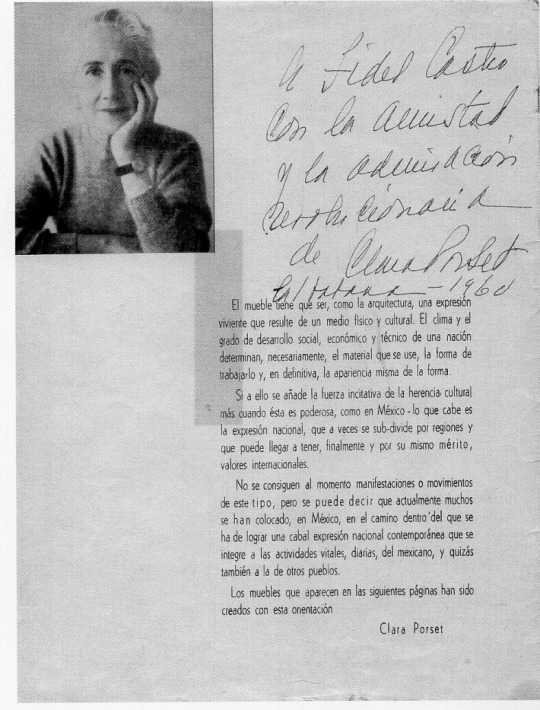
IRGSA with inscription from Clara Porset to Fidel Castro, 1960. | Photo via Salinas, Oscar. Una vida inquieta, una obra sin igual, UNAM, México, 2001
Such is the case of María Luisa Dehesa, the first Latin american architect to receive the degree in Mexico in 1937; Cuban industrial designer Clara Porset, who made her career in Mexico expanding the limits of Academia in the country and worked closely with Luis Barragan and Mario Pani; Nationalist promoter of the Mexican and first architect engineer from the National Polytechnic Institute Ruth Rivera Marín; North American Architecture Historian Esther McCoy whose fascination and critical view on Mexican Modernism would travel and impact the development of architecture and design in California; and first industrial designer, entrepreneur and promoter of Mexican modern design María Aurora Campos Newman.
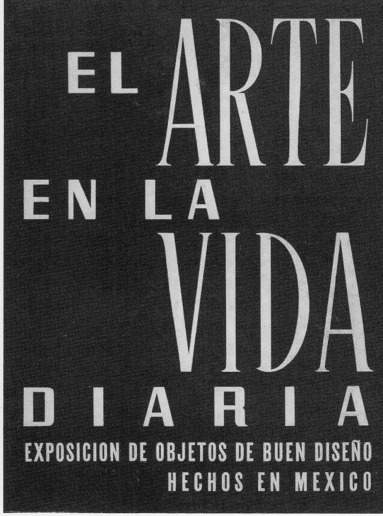
Poster of the exhibition “El arte en la vida diaria”. | Photo via Salinas, Oscar. Una vida inquieta, una obra sin igual, UNAM, México, 2001
The real revolution of these women wasn’t to find the crack in the guild’s wall, knock down the doors of their academia, nor open the windows of the discipline searching for fresh air, openness, creative and professional freedom, questioning with their actions the absolute trust with which the old architects confronted the world from their own collegiate and groups. Their greatest merit, was to create themselves a world to live in and share it with us.
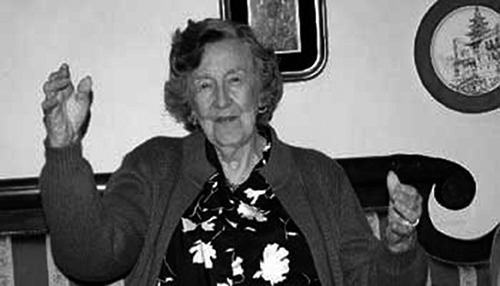
María Luisa Dehesa Gómez Farías (Mexico, 1912-2009) was the first woman to receive her architect degree in Mexico and Latin America, breaking the traditionally man-designated space on the discipline in the country. Her approach to architecture from a social perspective would be defined early on in her career when she proposed her thesis “Artillery Barracks Type” as a response to the high criminality among sons of soldiers that lacked a proper housing to share with their parent who remained quartered in the Barracks. Her proposal for the construction of a social family housing unit shaped her future projects and almost 50 year trajectory where she would continue to focus on housing in government dependencies on an urban scale in Mexico City’s Public Work Department.
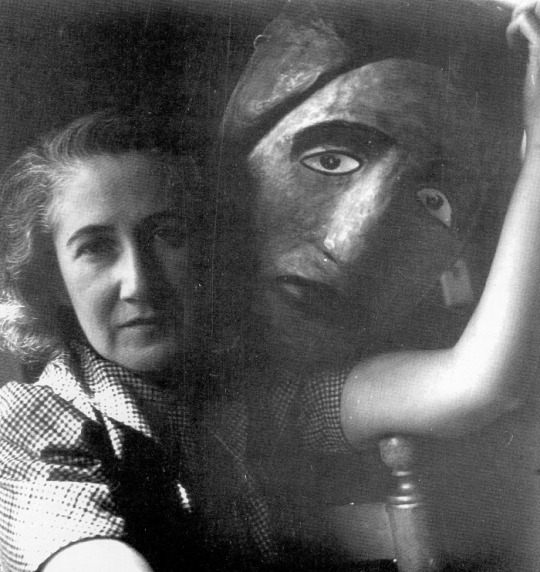
Clara Porset (Cuba, 1895-1981) was born in Cuba and became one the referent for Mexican design of the XX century. She studied architecture and furniture design in the Paris studio of Henri Rapin and attended classes at École des Beaux Arts, Sorbonne, and the Louvre. In 1934 she traveled to the United States to study under former Bauhaus instructors, artists Josef and Anni Albers at Black Mountain College. To her return to Cuba, she was briefly artistic director of the Technical School for Women, which she was forced to leave yet again due to her political stands. Back in Mexico, she married Mexican muralist Xavier Guerrero.

Clara Porset and Xavier Guerrero. | Photo via Salinas, Oscar. Una vida inquieta, una obra sin igual, UNAM, México, 2001
Her furniture designs would continue to be produced by Ruiz Galindo Industries (IRGSA) in the 50’s developing her E (wooden) and H (metal) - office furniture series. Porset later curated the exhibition Art in Daily Life: An Exhibition of Well-Designed Objects Made in Mexico at the Instituto Nacional de Bellas Artes in Mexico City in 1952, featuring handcrafted and mass-produced objects from local and international artists and designers.

Exhibition “El arte en la vida diaria” in Bellas Artes Museum, 1952. | Photo via Salinas, Oscar. Una vida inquieta, una obra sin igual, UNAM, México, 2001
By the end of the 50’s she returned this time to post-revolutionary Cuba to design the new society furniture visions of the revolutionaries in schools and universities.
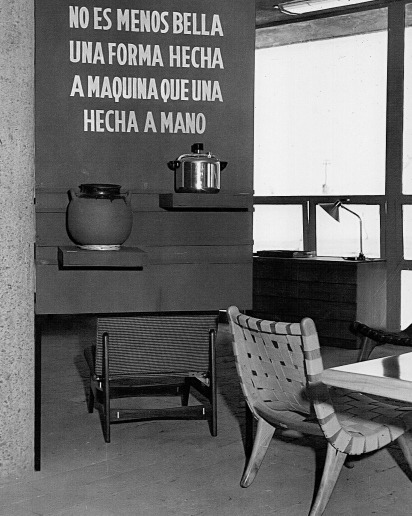
Exhibition “El arte de la vida diaria” in UNAM 1952. | Photo via Salinas, Oscar. Una vida inquieta, una obra sin igual, UNAM, México, 2001
She returned to Mexico then to teach Art History at the recently founded Industrial Design Program at the Universidad Nacional Autónoma de México, where she settled part of her legacy in Mexican Modern Design through her personal collection, library and archive.

Clara Porset’s chairs in the Julius Shulman studio in California, 1952. | Photo via Salinas, Oscar. Una vida inquieta, una obra sin igual, UNAM, México, 2001
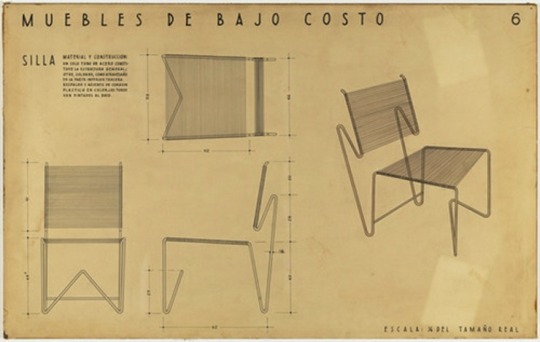
Clara Porset and Xavier Guerrero, Low Cost Design Competition Drawings, Museum of Modern Art. | Photo via Salinas, Oscar. Una vida inquieta, una obra sin igual, UNAM, México, 2001
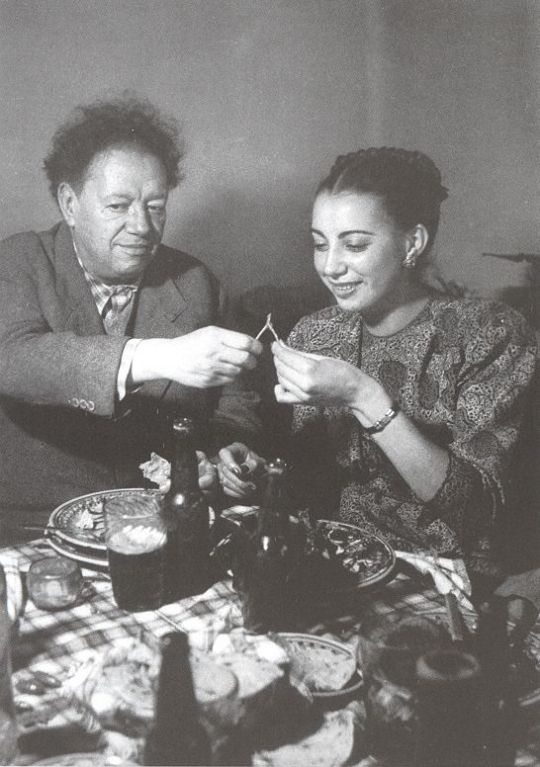
Diego Rivera and Ruth Rivera. | Photo via Fototeca Nacional
Ruth Rivera Marín (Mexico, 1927-1969) was the first woman to graduate from the College of Engineering and Architecture at the National Polytechnic Institute in Mexico in 1950. Daughter of Mexican renowned muralist Diego Rivera and well-known actress and writer Guadalupe Rivera Marín, she was early on introduced to the world of the arts and culture. She studied urban rehabilitation in Rome after working in the master plan for the city of Celaya, Guanajuato for the public service. She then returned to Mexico to teach architecture Theory, Architectural Composition and Urban Planning Theory, and furthering her intellectual acumen and nationalist ideal working closely with Diego Rivera and architects Juan O’Gorman, Pedro Ramírez Vázquez and Enrique Yañez.

Anahuacalli Museum in Mexico City. | Photo courtesy of Museo Anahuacalli
By the 1960’s she became head of planning for the Ministry of public Education’s National Systems of Regional Rural School. Rivera would later be involved on the building of the national Medical Center and the Museum of Modern art in close collaboration with Pedro Ramírez Vázquez; as well as with Luis Barragan on the Museum ‘El Eco’ in Mexico City. Her most noted work was the Anahuacalli Museum in association with Diego Rivera and Juan O’Gorman; and her design for the Mexican Pavilion for the 1962 Century 21 Fair in Seattle alongside Carlos Mijares. Rivera then ran Notebooks of Architecture and Conservation of the Artistic patrimony and its supplement Notebooks of Architecture, a journal of theory and practice in the discipline that was the basis for teaching in the XX Century in Mexico.

Anahuacalli Museum under construction. | Courtesy of Museo Anahuacalli

Mexican Pavilion Interior at the Seattle World's Fair Exposition in 1962. | Photo by postcard Ebay

Esther McCoy (USA, 1904-1989) was an American architecture critic and historian, instrumental in bringing the modern architecture of California to the world, shaping modernism in Los Angeles. Contributor to the magazine’s Arts & Architecture, Architectural Forum, Architectural Record, Progressive Architecture; the Los Angeles Times and The Los Angeles Herald-Examiner, as well as European journals L'Architectura and Lotus; her writing was a leading critical voice in a male-dominated architecture community, tracing the now well constructed Californian modernism identity.

Archives of American Art: Cuernavaca, ca. 1950 | Esther McCoy papers (1876-1990), bulk 1938-1989; Archives of American Art, Smithsonian Institution
However, less known is her contribution and broadcast of Mexican Modernism to California. During the year-long period spent in Mexico in 1951, her writing and observations of the vibrant and contextual modernist scene developing in Mexico during the 50’s; while drawing the references and connection in the design language and spatial articulation that architects from both places used, building a bridge between Mexico and California, the international and popular style, Luis Barragán and Rudolph Schindler, Clara Porset and Richard Neutra. During her trips to Mexico, she witnessed the construction of Mario Pani and Enrique del Moral Universidad Nacional Autónoma de México Campus, the domestic architecture of Luis Barragán, Juan O-Gorman, and Francisco Artigas, key figures of the the modernization in the country and brought them to an audience that knew little about it.
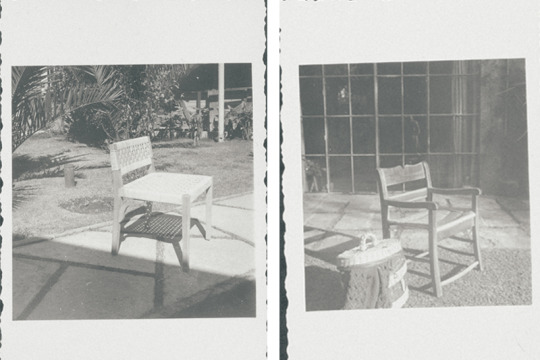
Research photographs: Furniture and Crafts, ca. 1950 | Esther McCoy papers, 1876-1990; bulk 1938-1989; Archives of American Art, Smithsonian Institution
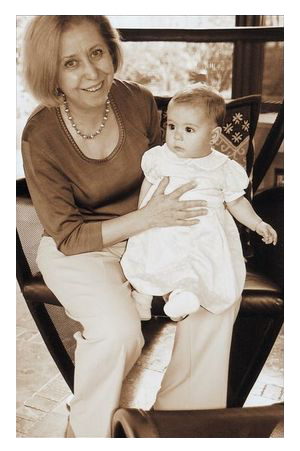
María Aurora Campos Newman de Díaz with her son. | Photo via Grupo di
María Aurora Campos Newman de Díaz (1941-2003) was the first Mexican woman in the country to graduate as industrial designer from the Universidad Iberoamericana in 1962 with a thesis on packaging for children beauty products. Inspired by her time working at the projects department at Knoll International, she left to Italy in 1965 to continue her studies at the Politecnico di Milano, and then to Germany in 1967 to study at the renowned Universität Ulm. After the school’s definite closing in 1968, she returned to Mexico in 1969, where she became famous for her commitment to promote design as founder of Grupo di in 1971, a company devoted the office-interior space planning, and designated Knoll’s distributed in Mexico until 1985.
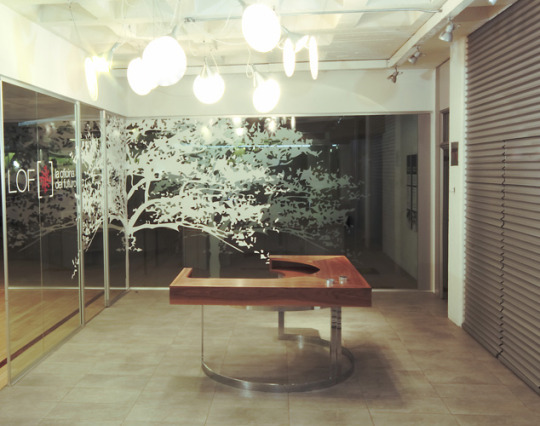
Recepetion oak wooden desk with chromed steel base. | Photo via Grupo di
Among her most renowned projects of her, was the new image for the international executive lounge for Mexicana de Aviación in Mexico City’s international airport; a project incorporating in the interior design, and integral way to incorporated furniture, exhibition stands, finishings and technology, opening a field of corporate interior design. In 1983, Campos Newman founded DA COLOR, a pioneer store in Mexico specialized in self-build furniture made by national designers. By 1988 Grupo di started importing Italian furniture and becoming the exclusive distributor in the country for Estel, Arflex, Matteograssi and Reixte; until 1999, from where she developed her own office furniture line, produced entirely in Mexico, Euro. Her entrepreneurial labor and integral philosophy towards design, carried an important role in the development and promotion of Mexican modern design.


International Executive Lounge "Mexicana de aviación", Mexico City International Airport. | Photo via Grupo di
---

by Tania Tovar Torres
157 notes
·
View notes
Text
Trabajo Recopilado por Chente Graterol.
Historia Médica del Estado Falcon, Sus Médicos.
Breve Biografia del Dr. JESUS ROMERO MORRELL ( 1921 - 2013)
Profesor de la Cátedra de Microbiología y Parasitología y Ex-ViceRector de la UNEFM
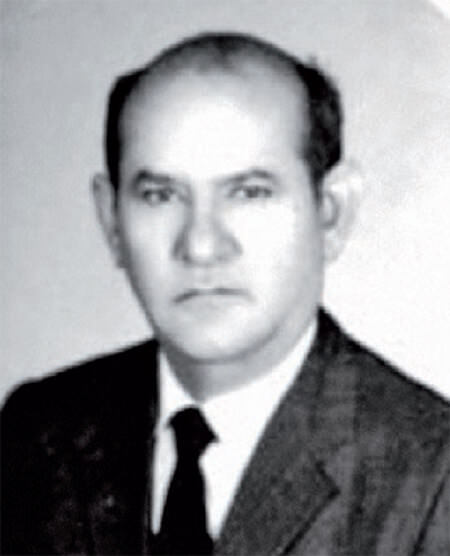
Como centinela de la República frente al océano impenetrable y misterioso, unas veces suaves y acariciados como un doncel enamorado y otras salvajes y feroz como un minotauro , aparece la Península de Paraguana, en donde palpitó por vez primera el corazón de Jesús Romero Morrell. Tierra millonaria en orquestaciones marinas y en visión de paisaje en donde los habitantes experimentan la alegría de vivir, es está de Falcón, signada por la gloria y el decoro desde sus remotos orígenes.
Galeno por vocación, puesto que para su espíritu selecto y apasionado del bien, la vida tiene una meta diáfana de servicio, sea cual fuere la posición señalada por el destino, consagró desde sus primeros años sus grandes energías y su claro talento al estudio medular para tener una formación de vastas y positivas facetas. Las enfermedades sociales llamaron poderosamente su atención y a resolver los problemas que las mismas provocan dirigió sus esfuerzos, mediante una especialización profunda y constante.
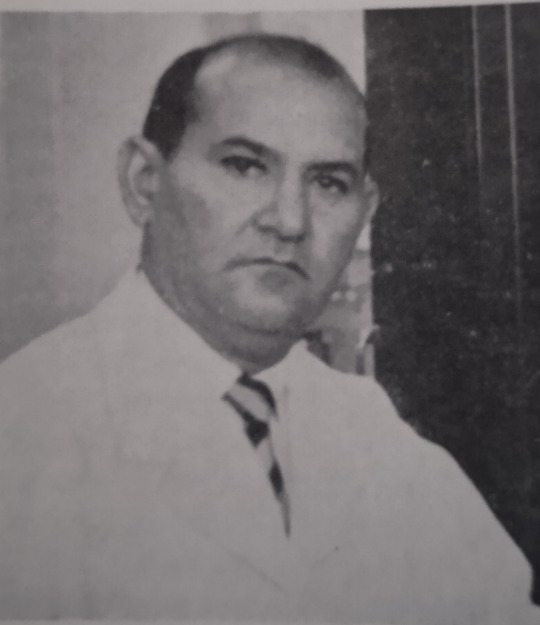
Jesús Romero Morrell nació en Pueblo Nuevo (Península de Paraguaná) Estado Falcón, el 29 de junio de 1921. Familia de agricultores Paraguaneros, Fueron sus padres Don Jesús Romero y su digna esposa Doña Zoila Morrell de Romero. Contrajo matrimonio con la distinguida Dama Thais Obadía de Romero el año de 1955. tuvo dos hijos: Irais, médica y Jesús, dedicado a actividades agropecuarias; El Dr. Jesús Romero Morrell inicio sus estudios primarios en la Escuela Federal de Pueblo Nuevo con el maestro Br. Héctor M. Peña y los concluyó en el Colegio Luis Espelozín de Coro con el Br. Nicolás Curiel Coutinho; los secundarios los cursó En el Liceo Cecilio Acosta de Coro, el 15 de septiembre de 1943, obtuvo el título de "Bachiller en Filosofía", título que en ese tiempo era expedido por la Universidad Central de Venezuela. Sus estudios universitarios los realizó en la Universidad Central de Venezuela (UCV), obteniendo el título de Médico Cirujano el 28 de Septiembre de 1949, perteneciendo a la Promoción "Dr. José Izquierdo" y obtuvo el título en Ciencias Médicas, en 1963. Realizó los cursos de posgrado en Médico Tropicalista en el Instituto de Medicina Tropical de la Universidad de Sao Paulo, Brasil (1960) y el de Médico Venereólogo en el Ministerio de sanidad y Asistencia Social (MSAS) y UCV (1944-50). En 1950 ingresó como Instructor (por concurso de credenciales) a la Cátedra de Medicina Tropical de la Escuela "Luis Razetti" (UCV). Cumplió todas las etapas del escalafón docente universitario hasta 1980. Cuando fue jubilado como Profesor Titular desde 1970 hasta 1980 que asume por concurso la jefatura de la Cátedra de Parasitología Médica de la Escuela de Medicina "Luis Razetti". En la Facultad de Medicina cumplió las siguientes responsabilidades: Miembro del Consejo de la Escuela (por elección) y presidente de dicho Consejo; Director (encargado) del Instituto de Medicina Tropical "Dr. Félix Pifano C"; fue Sub-Director del referido Instituto desde 1960 hasta 1980; Director del Departamento de Medicina Tropical, Microbiología y Parasitología, por varios períodos; Miembro de la Comisión de Becas y Relaciones Internacionales de la Facultad de Medicina, UCV y Representante principal de la Facultad de Medicina en el "Consejo de Desarrollo Científico y Humanístico" de la UCV. (1966-1974).
Por su fecunda labor que lo señalan como uno de los más valiosos especialistas en dermatología recibió merecidas distinciones, tales como: Premio "Martín Vegas" 1957 Sociedad de Dermatología, Venereología y Leprología de Venezuela; Premio "Medalla de Medicina Tropical" (1960) Instituto de Medicina Tropical Sao Paulo, Brasil; "Pirenochaeta romeroi", Nva. sp. Dante Borelli, Dermatología Venezolana, 1(4) junio 1959; Orden 27 de Junio 1ra Clase, Medalla de Oro; Orden "José María Vargas" 1ra Clase Corbata UCV; Orden "Josefa Camejo" Consejo Municipal del Municipio Autónomo Falcón, Pueblo Nuevo, estado Falcón y Orden "Dr. Calle Sierra", Consejo Municipal del Municipio Autónomo Miranda, Coro, estado Falcón. El Dr. Jesús Romero fue miembro de las siguientes sociedades científicas y profesionales: Federación Médica Venezolana, Colegio de Médicos del Distrito Federal, Royal Society of Tropical Medicine and Higiene (Londres), Sociedad Internacional de Dermatología Tropical, y Sociedad Parasitología Venezolana. Ha concurrido y presentado trabajos científicos en congresos nacionales e Internacionales y ha publicado treinta y tres (33) trabajos científicos relacionados con Leishmaniasis Visceral, (Kala-Azar) en Venezuela, la Bionphalaria glabrata de Venezuela a la infección con dos diferentes cepas de Schistosoma mansoni; Rev. Isn. Med. Trop. Sao Paulo, 20(6):318-322, Nov-Dic, 1978, estudio sobre Leishmaniasis tegumentaria en Venezuela (Premio Martín Vegas 1957 en cola, con el Pr. Dr. Rafael Medina.) "Leishmania pifanoi n.sp", entre otras investigaciones. En 1980, una vez jubilado de la UCV, a solicitud de su apreciado amigo y el colega Dr. Tulio Arends, primer Rector de la Universidad Nacional Experimental Francisco de Miranda (UNEFM) de Coro, viaja a Falcón para contribuir a la instalación de las cátedras de Microbiología y Parasitología y posteriormente de Medicina Rural de la Facultad de Ciencias de la Salud de aquella recién creada Institución Universitaria. En 1981 fue designado por el Ministerio de Educación Vicerrector Académico de la Universidad Francisco de Miranda; más tarde, el Concejo Universitario lo nombra Director de Investigaciones que equivale a un "Decanato de Investigación", en este caso ideado por el Dr. Arends para estimular la actividad investigativa en la UNEFM. En la Universidad Francisco de Miranda permanece hasta 1994, cuando regresa a Caracas; no abandona, sin embargo, sus contactos académicos con aquella Universidad. En Caracas, aunque retirado de la actividad académica, complacido mantiene las mejores relaciones de amistad con la nueva generación de investigadores. Como hijo de agricultores que pasó su infancia en el campo, le quedó el apego a la actividad agropecuaria la cual ejerció en viajes frecuentes a la finca de la familia llamada Sebastopol, en la Península de Paraguaná. El autor de gran parte de estas notas fue alumno del Dr. Jesús Romero.
El Dr. Jesús Romero Morell muere en Caracas el 04 de Julio del 2013 a la edad de 92 años. Hombre ejemplar que siempre estuvo dispuesto a extender su Mano a quien lo necesitara.
Honor a quien honor merece
#Nota: Información recopilada :
¶del Libro "El Estado Falcon y sus Médicos Nativos hasta 1950" de Gabriel Briceño Romero.
¶Recuento histórico del Departamento de Microbiología, Parasitología y Medicina Tropical. Zobeida Uzcátegui y Sofía Mata Essayag
0 notes
Photo

La cascada de Tamul es un salto de agua de México, el salto de agua más grande del estado de San Luis Potosí, en la cima del cañón del río Santa María, de 300 m de profundidad. La cascada del Tamul tiene 105 metros de altura. Está ubicada al norte del municipio de Aquismón, a aproximadamente 45 minutos de Ciudad Valles.
Nace del caudal del río Gallinas, que acaba desaguando cayendo sobre el cauce del río Santa María. El río que la alimenta cambia de nombre a río Tampaón, justo después aguas abajo de la cascada; todo esto localizado al oeste de Aquismón, en la región conocida como Huasteca. Se accede a la cascada por la carretera de San Luis Potosí, para tomar más tarde una desviación en la localidad El Sauz hasta el ejido La morena, donde cuentan con embarcadero oficial área de estacionamiento y lugares para acampar en el cual pueden contratar su lanchero el cual proporciona su equipo de seguridad para su viaje. El recorrido en lancha dura más de una hora, durante el cual se puede observar el paisaje a través del río. Es posible hacer rappel, entre otras actividades. Así como nadar en una impresionante cueva de agua cristalina con más de 45 m de profundidad y una tranquilidad y belleza absorbentes.
Se forma con la caída de las aguas del río Gallinas, que se integra por otros que nacen en el municipio de Tamasopo, San Luis Potosí. En los años 1960, los lugareños llamaban a la cascada "La Sonadora" por lo estruendoso de su caída en tiempos de lluvia. El río Santa María divide a Tamasopo y Aquismón en dirección N-S y el río Gallinas en la E-O; étnicamente, también es frontera entre teeneks (huastecos) y pames (Xi'oi, que se pronuncia Shihuí o Chihui y no Choy o Xoiu como aparece en muchos escritos).
Tamúl se encuentra en una región donde las caídas de agua son abundantes: en un radio de 100 km se encuentran, en el municipio de Rayón, La Llovinosa y Los Chorros; en el de El Naranjo, el Salto de Tanloquen, El Meco y Minas Viejas; en Xilitla, Las Pozas en el jardín surrealista de Edward James; en Ciudad Valles, Micos y en Tamasopo, las cascadas de Tamasopo Viejo, Puente de Dios, El Paraíso, California, El Aguacate, Las Cascaditas y tres sin explorar, de importante altura, en el río San Nicolás de los Montes, afluente del Gallinas. Además de éstas, hay innumerables parajes y ríos subterráneos y el último humedal de San Luis Potosí, la Ciénaga de Tampasquín en Tamasopo, conocida como ciénega de Cabezas. [email protected]
0 notes
Text
读书笔记 | 短命国旗与复活国旗小识录
亚马逊的Kindle Unlimited是个不错的东西,我在日本亚马逊上每月花980日元订阅了这项服务,一个账户可以借阅10本Kindle Unlimited的书或杂志,没事搜罗搜罗,还是会有不错的发现。
最近搜罗的是各种「图鉴」,比如这本「最新版 国旗と国章図鑑」(世界文化社, 2018.12)。

国旗这种东西是常看常新,这次看又有一些新发现。
比如发现几面格外短命的国旗。像1903年的巴拿马,在不到2个月的时间里,换了两面国旗。最初的版本是巴拿马首任总统的夫人María de la Ossa de Amador在11月1日制作的,当时巴拿马还没有脱离哥伦比亚,而11月3日巴拿马宣布独立时,这面旗帜已经飘扬在巴拿马城了。

当时的版本是蓝色色块在左上角,后来蓝色被赋予象征保守党的含义,如果将这个重要的位置留给一个政党会显得不够公正、平衡,于是将白色色块调换了上来,并在1903年12月20日经立法确定为现在的样子。

说起短命的国旗,塞浦路斯在1960年4月6日-8月16日间使用的国旗也算一个。塞浦路斯国旗是1960年通过设计竞赛产生的,根据当时的宪法,国旗不能包含蓝色或者红色(希腊与土耳其的颜色)、也不能出现十字架或新月这样的宗教符号,以让国旗保持中立。
虽然在塞浦路斯分裂之后,这面国旗主要由希腊族人使用,但国旗的设计者却是一位土族人İsmet Güney,他后来生活在北塞浦路斯,但晚年还向塞浦路斯政府追索设计费,据说塞浦路斯首任总统马卡里奥斯三世曾经答应他每年支付20英镑的设计费,但结果一笔都没收到……

塞浦路斯国旗是少有的在旗面上描绘国家地图的国旗(另一个是科索沃,以及孟加拉国第一面国旗)。在最初的版本里,地图的颜色是白色的,由黄铜色描边,但是这种设计制作起来并不便利,因此后来改为完整的黄铜色色块。

刚刚提到的孟加拉国首面国旗也是一面短命国旗,从1971年3月使用到1972年1月17日。后来的国旗去掉了红色圆盘里的孟加拉地图。

据说取消地图的原因是,地图会让人联想起东西巴基斯坦令人不愉快的分裂,而且从反面看是反的。

而在看到看到塔吉克斯坦这页时,发现一个之前不知道的事情。那就是1991-1992年,在这短短的一年间,该国曾经使用过另一面国旗。
很明显,这面短命国旗,只是简单地去掉了苏联时代国旗上的镰刀锤子五角星。现在塔吉克斯坦国旗1992年11月才启用,这也让塔吉克���坦成为最后一个采用新国旗的前苏联国家。

按照塔吉克苏维埃社会主义共和国国旗的设计理念,红色代表共和国的统一和工人革命,白色象征棉塔吉克农业的基础花生产,绿色代表其他农产品。而红色、白色和绿色也是泛伊朗色彩,是共和国波斯文化的标志,在苏联加盟共和国的国旗里也是比较特别的。而这套泛伊朗色彩,也被后来的国旗继承下来。

苏联解体时,宣布独立的各个加盟共和国其实都面临着换国旗的问题。
有一些加盟共和国,在独立后依然把过去的国旗原封不动地沿用了一段时间,直到1992年设计出新国旗。中亚加盟共和国大多属此例,因此在某种意义上,这些国旗也是短命国旗。
哈萨克苏维埃社会主义共和国国旗 → 哈萨克斯坦共和国国旗(1991年12月16日 - 1992年6月4日,也有资料称,因为新国旗制作工艺复杂,有法律法律允许旧国旗继续使用到1994年1月1日)

有资料称,哈萨克斯坦新国旗最初的版本,靠近旗杆处的民族纹饰是红色的,而非今天的金黄色。但在很短的时间里,这面国旗就被放弃了,纹饰换成了与旗面上太阳、飞鹰相同的金黄色。

后来纹饰样式又有所修改,成为今天的模样。这面国旗由艺术家Shaken Niyazbekov设计,其艺术美感,在全世界国旗里都是数一数二的。

吉尔吉斯苏维埃社会主义共和国国旗 → 吉尔吉斯斯坦共和国国旗(1991年8月31日-1992年3月3日,1993年改名吉尔吉斯共和国)

新国旗设计的也不错,红色的旗面象征「勇敢」,红色也是英雄玛纳斯的颜色。中间的太阳象征「和平与繁荣」,四十道光芒代表被玛纳斯联合起来与蒙古人作战的40个部落。

旗面上的图案来自传统民居毡房(tunduk)的房顶,还原度很高,还象征着"生命的起源”、"时间和空间的统一”。

平心而论,这面国旗设计的也很不错。不过近年来,在吉尔吉斯斯坦政治动荡、族群冲突的背景下,有少数民族群体认为,本民族曾被玛纳斯征服,并不认同这面源自玛纳斯战旗的旗帜。也有人认为红色的旗面,让人想起苏联时代。
土库曼苏维埃社会主义共和国国旗 → 土库曼斯坦国旗(1991年10月27日 - 1992年2月19日)
旗帜中的两条蓝色横纹,代表阿姆河和锡尔河(然而锡尔河并不流经土库曼斯坦)。

土库曼斯坦的新国旗1992年2月19日正式启用,在征集设计方案时,要求「只考虑祖先的传统和民族特性」,这点反映出来就是旗杆处沿线5块传统地毯图样的设计,也使其成为世界上设计最复杂的国旗。

这面国旗使用的时间也不长。1997年五块地毯下面增加了一个橄榄枝的图案,象征土库曼斯坦的永久中立国地位,并且调整了五颗星的位置。

2001年又调整了尺寸,从1:2改为2:3。

像塔吉克斯坦这种去掉苏联标志的情况,其实是比较特殊的。
另外,一部分加盟共和国在提出主权宣言后(1990-1991),就迫不及待的地采用了新国旗(甚至禁用之前带有苏联元素的国旗),而这些旗帜在独立后也成为新国家的国旗。乌兹别克斯坦,是中亚五国中���早开始设计新国旗的。1991年8月31日宣布独立,很快便开始征集新国旗的方案,1991年11月18日便确定了现在国旗的样式。波罗的海��国、外高加索三国、俄罗斯、乌克兰、摩尔多瓦也属此例,而且新国旗基本上都是历史上使用过的。
只有白俄罗斯比较特殊,先是在1991年复活了1918年的老国旗,紧接着又在1995年复活了苏联时代的旗帜。
1991年采用的这面旗帜,来自于1918年的白俄罗斯民主共和国,一般被称作「白红白旗」。白色和红色是历史上立陶宛大公国和波兰-立陶宛联邦的代表颜色。

也有说法认为是来自立陶宛大公国的纹章Pahonia,这个纹章也是1991-1995年白俄罗斯的国徽。

1991-1994年的白俄罗斯政治体制依然延续了苏维埃制,直到1994年才改行总统制。卢卡申科当选总统之后,就开启了更换国家标志的进程,并在1995年发起一次全民公决,87%的投票者支持更换国旗。
在全民公决之前的舆论造势中,白俄罗斯的官方媒体称「白红白旗」是卫国战争期间纳粹合作者的标志、是法西斯符号。更戏剧的是,在全民公决结果发布之前,卢卡申科的行政主管Ivan Titenkov还亲自爬上政府大楼楼顶,降下「白红白旗」并当众弄碎。因为当时新国旗生效的法令还没有签署,反对者还曾想以破坏国旗的罪名给Titenkov治罪。

白俄罗斯的新国旗脱胎于苏联时代的国旗。旗杆一侧的图案,源自一种名叫Ruchnik的白俄罗斯民族织物,国旗上的纹样来自档案中的图片,是在1917年由农民Matrona Markyevich制作,后由艺术家M. I. Gusyew修改。

1995年的版本去掉了苏联的象征符号,并调整了旗杆侧织物的样式。

2012年又对织物的样式进行了调整,成为了今天的模样。
国旗这种东西,本就是政治的产物,可以因政局变换而废弃,也可以因此而复活。在看「最新版 国旗と国章図鑑」时,还发现几例。
例如加纳国旗,现在的版本启用于1957年,1964年恩克鲁玛搞了一次宪法全民公决,决定人民大会党成为唯一合法政党,随后国旗便从「红黄绿」三色旗改为「红白绿」,和人民大会党的党旗一致。1966年恩克鲁玛被推翻后,国旗便又换回了之前的版本。

巧合的是,匈牙利国旗也是「红白绿」,相比于之前的颇具特色的泛非主义旗帜,少了些个性。

再如赤道几内亚国旗,目前的国旗早在1968年便已启用。然而在1973年弗朗西斯科·恩圭马当政期间,国旗上使用了不同的国徽。1979年恩圭马倒台,推翻他的是他的侄子特奥多罗·奥比昂·恩圭马。这位恩圭马上台之后,又恢复了1968年的国旗。

老恩圭马时期的国徽便是当时赤道几内亚唯一合法政党劳动国民统一党的党徽,由几把工具、一把剑和一只鸡组成,还写着国家格言:Trabajo(工作)以及Unidad(统一)、Paz(和平)、Justicia(正义)。

被复活的还有马拉维老国旗,「黑红绿」三色来自独立时执政党马拉维大会党。2010年,民主进步党领导的政府提议更换国旗,三色顺序改为「红黑绿」,原国旗顶端的「朝阳」被位于旗面中央的白色太阳取代,45套光线代表马拉维独立以来的经济进步。反对党联合民主阵线反对变更国旗,但总统宾古·瓦·穆塔里卡依然批准了新国旗。这个国旗在马拉维国内并不受欢迎,被戏称为「宾古旗」。2012年宾古死后,在新总统的领导下,议会投票决定恢复独立时的国旗。

平心而论,马拉维这两面国旗设计的都还不错,不过相比于这面「正午旗」,被复活的「朝阳旗」似乎更有意境。

太平洋小国图瓦卢在1995年到1997年4月间,连换了两面国旗。当时是总理Kamuta Latasi,当政期间一直在折腾国旗这件事。1978年独立时的图瓦卢国旗有9颗星,1995年去掉了1颗星,因为「图瓦卢」的意思是「八个一起」。

1996年1月,又重新设计了国旗,去掉了左上角的米字旗,还保留了8颗星。不过当地居民并不喜欢这面国旗,认为这是要用共和制取代君主立宪制。不过也有人认为这一举措,让图瓦卢告别了殖民时期的记忆。(说实话,这个国旗的设计真的很不好看)

1996年12月24日,Kamuta Latasi卸任。新当选的总理Bikenibeu Paeniu在1997年4月,又恢复了1978年的米字旗+9颗星的国旗。

所以说,��面上是国旗之争,实则是政治之争,但不管怎样,都是折腾。
关于读这本书时的其他发现,会陆续在微博上更新。
以上。
0 notes
Photo

[TASK 090: BOLIVIA]
There’s a masterlist below compiled of over 130+ Bolivian faceclaims categorised by gender with their occupation and ethnicity denoted if there was a reliable source. If you want an extra challenge use random.org to pick a random number! Of course everything listed below are just suggestions and you can pick whichever character or whichever project you desire.
Any questions can be sent here and all tutorials have been linked below the cut for ease of access! REMEMBER to tag your resources with #TASKSWEEKLY and we will reblog them onto the main! This task can be tagged with whatever you want but if you want us to see it please be sure that our tag is the first five tags, @ mention us or send us a messaging linking us to your post!
THE TASK - scroll down for FC’s!
STEP 1: Decide on a FC you wish to create resources for! You can always do more than one but who are you starting with? There are links to masterlists you can use in order to find them and if you want help, just send us a message and we can pick one for you at random!
STEP 2: Pick what you want to create! You can obviously do more than one thing, but what do you want to start off with? Screencaps, RP icons, GIF packs, masterlists, PNG’s, fancasts, alternative FC’s - LITERALLY anything you desire!
STEP 3: Look back on tasks that we have created previously for tutorials on the thing you are creating unless you have whatever it is you are doing mastered - then of course feel free to just get on and do it. :)
STEP 4: Upload and tag with #TASKSWEEKLY! If you didn’t use your own screencaps/images make sure to credit where you got them from as we will not reblog packs which do not credit caps or original gifs from the original maker.
THINGS YOU CAN MAKE FOR THIS TASK - examples are linked!
Stumped for ideas? Maybe make a masterlist or graphic of your favourite faceclaims. A masterlist of names. Plot ideas or screencaps from a music video preformed by an artist. Masterlist of quotes and lyrics that can be used for starters, thread titles or tags. Guides on culture and customs.
Screencaps
RP icons [of all sizes]
Gif Pack [maybe gif icons if you wish]
PNG packs
Manips
Dash Icons
Character Aesthetics
PSD’s
XCF’s
Graphic Templates - can be chara header, promo, border or background PSD’s!
FC Masterlists - underused, with resources, without resources!
FC Help - could be related, family templates, alternatives.
Written Guides.
and whatever else you can think of / make!
MASTERLIST!
F:
Encarnación Lazarte (1938) Bolivian [Quechua] - singer and composer.
Raquel Welch (1940) Bolivian / English - actress and singer.
Matilde Casazola (1943) Bolivian - poet and songwriter,
María Tirado (1945) Bolivian - singer.
Enriqueta Ulloa (1952) Bolivian - singer.
Zulma Yugar (1952) Bolivian - singer.
Emma Junaro (1953) BOlivian - singer and musician.
Luzmila Carpio (1954) Bolivian [Quechua] - singer.
Nena Zeballos (1959) Bolivian / Peruvian - singer.
Betty Veizaga (1957) Bolivian - musician.
Tahnee Welch (1961) Bolivian, English / Unspecified - actress and model.
Ana Cristina Céspedes (1962) Bolivian - singer.
Julieta Paredes (1967) Bolivia - poet, singer, writer and artist.
Beatriz Méndez Leclere (1967) Bolivian - mezzosoprano.
Verona Feldbusch (1968) Bolivian - TV personality, beauty pageant winner, and actress.
Verona Pooth (1968) Bolivian - beauty pageant contestant.
Giovana Chávez (1969) Bolivian - actress, model and presenter.
Erika Andia (1972) Bolivian - actress, director and journalist.
Verónica Larrieu (1974) Bolivian - model.
Beby Aponte (1974) Bolivian - singer.
Guide Santa Cruz (1975) Bolivian - singer and folklorist.
Nina Uma (1975) Bolivian [Aymara / Quechua] - singer, activist, radio and television host.
Tanya Callau (1976) Bolivian - actress and model.
Esther Marisol (1976) Bolivian - singer.
Monica Ergueta (1977) Bolivian - singer.
Paola Zeballos (1977) Bolivian - singer.
Carla Ortiz (1978) Bolivian - actress.
Soledad Ardaya Morales (1978) Bolivian - actress..
Ximena Herrera (1979) Bolivian - actress and singer.
Stephanie Beatriz (1981) Bolivian [Unspecified Indigenous, Spanish, Basque, possibly other] / Colombian [German, 1/4 Sephardi Jewish, Dutch, Spanish, Basque, possibly other] - actress.
Rocío Moreira Troche (1981) Bolivian - singer.
Susana Renjel Encinas (1981) Bolivian - singer.
Vanessa Alfaro (1983) Bolivian - model, actress, singer, and fashion designer.
Olivia Pinheiro (1983) Bolivian / Brazilian - model and Miss Bolivia 2010.
Jessica Jordan (1984) Bolivian / English - model and beauty pageant titleholder.
Dominique Peltier (1986) Bolivian - Miss Bolivia Universo 2008.
Desiree Durán (1985) Bolivian - actress, TV presenter, model and beauty pageant contestant.
Sandra Hernández (1985) Bolivian - Miss Bolivia World 2007.
Yéssica Mouton (1988) Bolivian - model and Miss Bolivia 2012.
Yovana O'Brien (1988) Bolivian [Irish] - Miss Bolivia Earth 2010 and Miss Bicentenario.
Ana María Ortiz (1989) Bolivian - model and Miss World 2006.
Claudia Tavel (1989) Bolivian - model and Miss Bolivia 2013.
Jackelin Arias (1990) Bolivian - beauty pageant contestant.
Anabel Angus (1990) Bolivian - model and tv host.
Stephanie Herela (1990) Bolivian - model and actress.
Claudia Arce (1991) Bolivian - actress, singer, model and beauty pageant titleholder.
Dayanna Grageda (1992) Bolivian - model.
Romina Rocamonje (1992) Bolivian - model and Miss Bolivia 2014.
Andrea Roman (1994) Bolivian - blogger.
Jazmin Duran (1994) Bolivian - Miss Earth Bolivia 2015.
Alexia Viruez (1994) Bolivian - model and Miss Bolivia 2012.
Luciel Izumi (1994) Bolivian - musician.
Megamy Bowles (1995) Bolivian - singer.
María Renée Carmona (1995) Bolivian - Miss Earth 2013 and Miss United Continent.
Gleisy Noguer (1996) Bolivian - Miss Universe 2017.
Camila Paz Chavez (1999) Bolivian - Instagrammer.
Elysia Crampton (?) Bolivian [Aymara] - musician.
Alexia Dabdoub (?) Bolivian - actress.
Erika Pitstick (?) Bolivian / American - actress.
Natalie Conneely (?) Bolivian [Incan] / Irish - actress.
Elisabeth Salazar (?) Bolivian, Belgian - actress.
Katia Escalera (?) Bolivian - soprano.
Eloísa Gutiérrez (?) Bolivian - Miss Earth Bolivia 2014.
Brenda Lowe (?) Bolivian / Chinese - cheerleader and beauty pageant contestant.
Stella Fernandez (?) Bolivian - model.
Rosa Rivers (?) Bolivian - actress.
Liliana Castellanos (?) Bolivian - fashion designer.
Rosita Hurtado (?) Bolivian - fashion designer.
Carla Morón (?) Bolivian - model.
Arminda Alba (?) Bolivian - singer.
Jenny Cárdenas (?) Bolivian - singer.
Gina Gil (?) Bolivian - singer.
Luisa Molina (?) Bolivian - singer.
Katia Ladder (?) Bolivian - singer.
Neyza (?) Bolivian - singer, television presenter and radio announcer.
M:
Atiliano Auza León (1928) Bolivian - singer and musician.
Omar Duranboger (1937) Bolivian, German - artist, sculptor, painter, and actor.
Jaime Torres (1938) Argentinian [Bolivian] - musician.
David Santalla (1939) Bolivian - actor and comedian.
Ernesto Cavour (1940) Bolivian - singer, musician, artist, inventor of musical instruments and author.
Luis Rico (1945) Bolivian - singer-songwriter.
Luis Carrion (1945) Bolivian - singer.
Erwin Vaca Pereyra (1947) Bolivian - musician.
Pepe Murillo (1947) Bolivian - singer and presenter.
Hernando Irahola (1948) Bolivian - singer.
Eddy Navia (1949) Bolivian - singer-songwriter, composer and musician.
Arturo Lora (1950) Bolivian - actor.
Aldo Peña (1950) Bolivian - singer.
Gonzalo Hermosa González (1950) Bolivian - singer and composer.
César Junaro (1951) Bolivian - musician.
Porfirio Conde Ramírez (1955) Bolivian - singer-songwriter.
Pato Hoffmann (1956) Bolivian [Aymara, Quechua, Spanish, German] - actor.
Jorge Ortiz Sánchez (1956) Bolivian - actor and poet.
Damon Welch (1959) Bolivian, English / Unspecified - actor.
Beautiful Elmer (1960) Bolivian - singer and composer.
Rodrigo Uriarte Stottuth (1960) Bolivian - musician.
Manuel Monroy Chazarreta (1961) Bolivian - singer-songwriter and guitarist
Willy Claure (1962) Bolivian - composer and guitarist.
Milton Cortez (1962) Bolivian - singer, composer and actor.
Yuri Ortuño (1963) Bolivian - singer and composer.
Juan Carlos Rodríguez Clavijo (1963) Bolivian - singer, musician, composer and folklorist.
Yalo Cuellar (1963) Bolivian - musician and composer.
Fernando Torrico (1964) Bolivian - singer and musician.
Miguel Orias (1965) Bolivian - singer.
Piraí Vaca (1967) Bolivian - guitarist.
Grillo Villegas (1968) Bolivian - songwriter, guitarist and singer.
Oscar Peñafiel Rodriguez (1968) Bolivian - guitarist.
Ariel Villazón Torrico (1969) Bolivian - singer-songwriter, charangoist, soundman and musician.
Omar González Onostre (1970) Bolivian - singer and musician.
David Kavlin (1971) Bolivian / Argentinian [German Jewish, Belgian Jewish, Ukrainian Jewish] - actor, singer, tv personality, and radio personality.
Miguel Valverde (1973) Bolivian - actor, director, screenwriter and filmmaker.
Hernán Ergueta (1974) Bolivian - author and composer multi-instrumentalist.
Wally Zeballos (1975) Bolivian - singer.
Juan Carlos Aduviri (1976) Bolivian - actor.
René Eduardo (1976) Bolivian - singer, composer, actor.
Christian Laguna (1976) Bolivian - bassist, composer, producer and musical director.
Jorge Vargas (1977) Bolivian / Argentinian - actor.
Dalmiro Cuéllar Ayala (1978) Bolivian - singer.
Nial Gandarilla (1979) Bolivian - musician.
Klovis Herboso (1979) Bolivian - singer.
Omar Ríos (1979) Bolivian - singer and musician.
Braulio Choque (1980) Bolivian [Aymara] - researcher , writer , painter and singer-songwriter.
Álvaro Velasco (1981) Bolivian - singer, composer and folklorist, vocalist and director.
Aníbal Guzmán Miranda (1985) Bolivian - musician and composer
Reynaldo Pacheco (1987) Bolivian - actor.
Diego Zegarra (1992) Bolivian - viner.
FwOmarr (1999) Bolivian - instagrammer and youtuber.
David Barrera (?) Bolivian - actor.
James T. Slater (?) Bolivian - singer-songwriter.
Desiderio Arce (?) Bolivian [Quechua] - singer.
Nicolas Jung (?) Bolivian, Hungarian - actor.
Cristian Mercado (?) Bolivian - actor.
Hugo Well (?) Bolivian - actor.
David Mondacca (?) Bolivian - actor.
Alvaro Alarcón (?) Bolivian - hair stylist and make-up artist.
Ingrid Hölters (?) Bolivian - fashion designer.
Jaime Junaro (?) Bolivian - singer-songwriter and guitarist.
14 notes
·
View notes